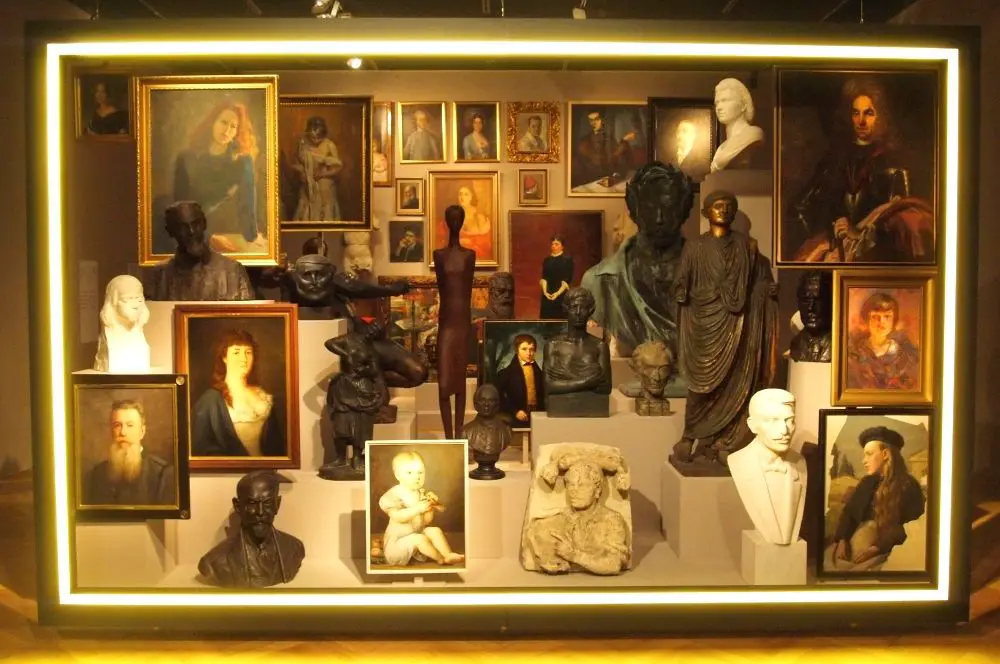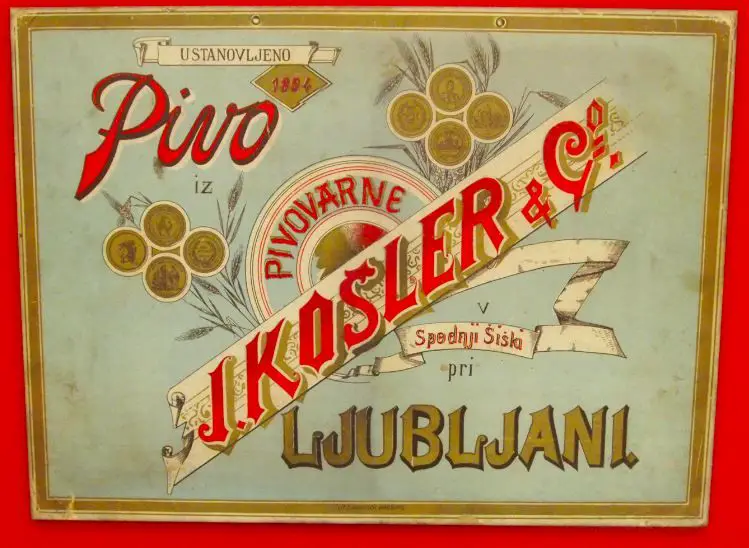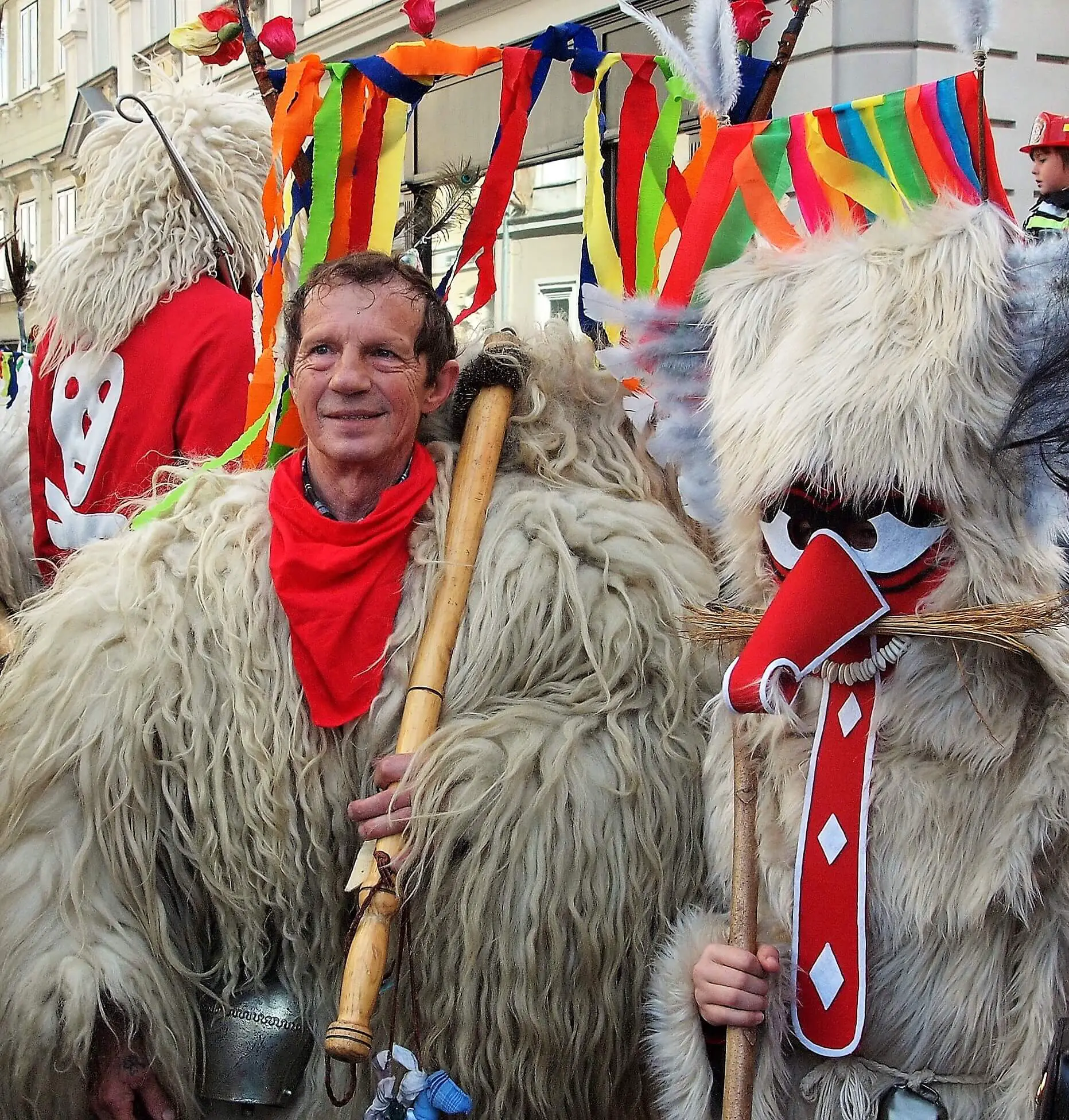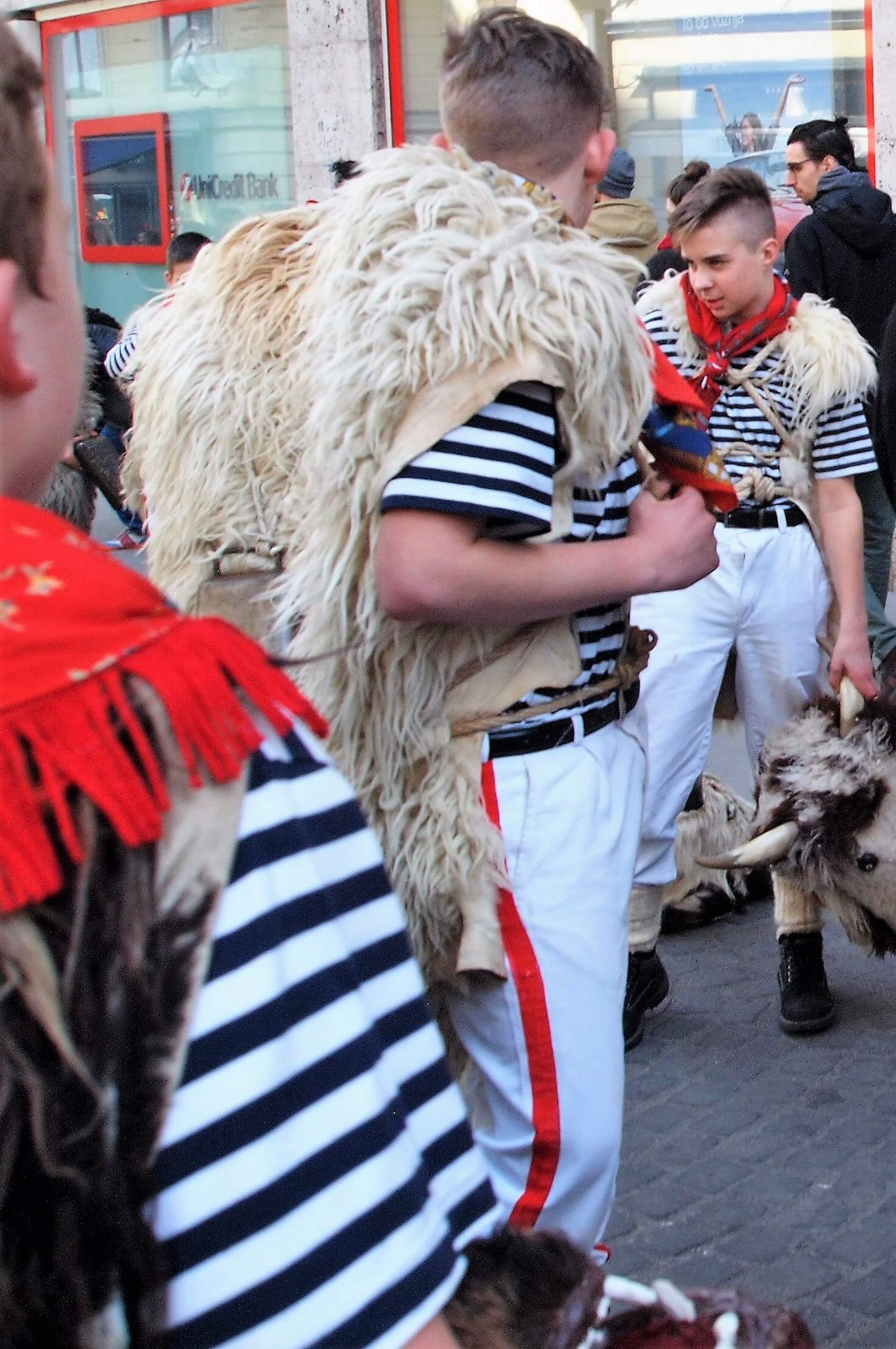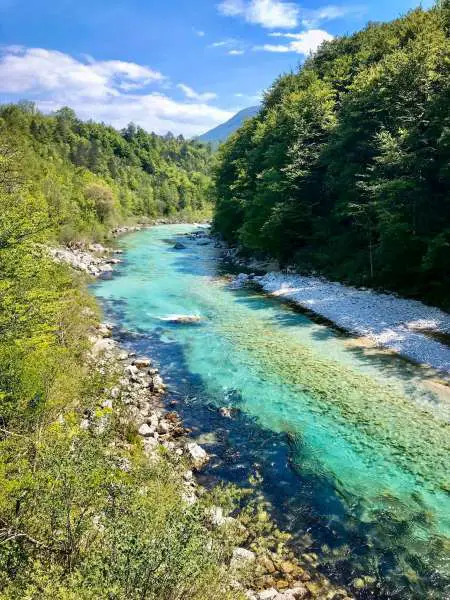Lifestyle
STA, 8 March 2019 - A report released by the Organisation for Economic Cooperation and Development (OECD) on Friday places Slovenia eighth in terms of gender equality among 120 countries. Standing out as the biggest issue for Slovenia is the level of discrimination in the family.
The OECD's SIGI index (Social Institutions and Gender Index) is a cross-country measure of gender-based discrimination in society, with the index value 100% meaning the highest measurable level of discrimination.
The index for Slovenia was 12.9% this year, which put Slovenia in the "very low" discrimination category.
When looking at specific indicators of discrimination, Slovenia fared the poorest in the prevention of discrimination in the family (SIGI value of 21.8%).
Regarding restricted physical integrity, Slovenia received the index of 7.1%. In terms of restricted access to productive and financial resources, the country's index was 9%, and in the category of restricted civil liberties, the value was 13.2%.
Slovenia ranks behind Austria, Belgium, Portugal, France, Sweden, Denmark, and Switzerland. The latter ranked the highest with the index of 8.1%, while Yemen ranked the lowest with a discrimination level of 64%.
60 countries could not be ranked due to insufficient data. In general, gender inequality is lowest in Europe and highest in Africa.
The fourth edition of the ranking suggests that besides legal measures, cultural, social, and religious norms need to be taken into consideration to eliminate discrimination.
According to the OECD, the current level of discrimination deprives the global economy of USD 6,000bn, which amounts to 7.5% of global GDP.
Since the previous study in 2014, 15 countries have criminalised domestic violence, the same number have made marriage under the age of 18 illegal. Eight countries have implemented legal measures to ensure a gender-balanced representation among elected state officials.
Paid maternity leave is ensured everywhere, apart from Papua New Guinea and the US.
You can see the full OECD report here, while the detailed report for Slovenia, in PDF form, is here
Spring’s almost here and the chairs outside cafés and bars are starting to fill up again, giving you the chance to sit and watch the life of the city unfold before deciding to re-enter the stream. One indoor event to consider this week is the 21st Documentary Film Festival (13 – 20), this year's produced in cooperation with Amnesty International and featuring a Werner Herzog Retrospective. More details are in the cinema section, below, while the programme is here.
Want to practice your English by giving or hearing science presentations? Then learn more about Science Bites, who organise such events for free and hold them at ŽMAUC. This week, Tuesday 15, from 19:00 to 20:00, there will be talks on "Sex with the wrong female: Causes and consequences of reproductive interference", "Particle detectors: the way we can "see" particles!" and "Arts in education and the power of abstract thinking". The events page for this group is here.
If you're not in town for the week of this guide (March 11 - 17, 2019) then you can see all the editions here, and you can enhance your stay in the city and impress or annoy friends and companions by learning some obscure facts about the city here, and the Castle here.
As ever, clicking on the venue names in the list below should get you more details with regard to the time, price and location, as well as other events on at this place in whatever week you're here. Finally, if there's something you want to promote in a future edition of What's on in Ljubljana please get in touch with me at flanner(at)total-slovenia-news.com
- Cinemas and films
- Clubbing
- Live music
- Opera, theatre and dance
- Harm reduction and drug testing
- Things to do with children
- LGBT+ Ljubljana
- Ljubljana Castle
- Museums and galleries
- Other things to do in Ljubljana
- Daytrips
- Getting around & miscellaneous
Cinemas and films
You can read about all the cinemas in town here, while a selection of what’s playing this week is below, and note that kid’s movies tend to be shown in dubbed versions, so do check before driving out to a multiplex and dropping off the young ones if they can't understand Slovene. Parents should also pay attention to Kinobalon, which is Kinodvor's regular weekend series of film screenings and events for children, from babies on up, with special parent/child events, "first time in a cinema" screenings, and babysitting. Learn more about it here, and see the current schedule here.
Cankerjev dom – The main arts centre in the country is one of the hosts of the annual documentary film festival, and the schedule is here.
Kinodvor – The arts cinema not far from the train station is showing, among other films, Green Book, Colette, Faces Places, Beautiful Boy, Vision, Climax, #Female Pleasure (with the Wednesday, 17:15 screening followed by a talk with the director), Sakawa (Thursday 18:15, also followed by a talk with the director), and Putin’s Witnesses (Saturday, 20:30, talk with the director).
Kinoteka – This revival cinema isn’t far from Kinodvor, at the train station end of Miklošičeva, is showing, among other features, Mike Leigh’s Naked, John Huston’s Annie, Alfonso Cuarón’s Y Tu Mamá También, and a short Werner Herzog season (that continues next week) with Fata Morgana, Lo and Behold: Reveries of the Connected World, Land des Schweigens und der Dunkelheit, Little Dieter Needs to Fly, Echos aus einem düsteren Reich, and Lektionen in Finsternis.
Kino Bežigrad - A little out of town, but not more than short drive or bus ride away, you can see Captain Marvel and a dubbed version of How to Train Your Dragon 3.
Kolosej - The multiplex out at BTC City Mall is playing all the big movies, which this week include Captain Marvel (2D and 3D), How to Train Your Dragon: The Hidden World, Green Book, Vice, Ralph Breaks the Internet: Wreck-It Ralph 2 (dubbed), A Star is Born, Bohemian Rhapsody, Escape Room, Lego Film 2, Cold Pursuit, Alita: Battle Angel (2D and 3D), Qu'est-ce qu'on a encore fait au bon Dieu?, Happy Death Day 2U, Instant Family, Mia et le lion blanc, a dubbed version of Liliane Susewind, The Favourite, Replicas, Izbrisana, and a dubbed version of The Queen’s Corgi. New this week are Colette and Posljednji Srbin u Hrvatskoj. Note that there are far more movies than screens, so some of the older ones may only be playing once or twice a week. Click on the theatre name to see the actual times before making a date.
Komuna – The cinema in a basement behind Nama department store is showing Collete, The Upside and Green Book.
Clubbing
Compared to some European capitals it can seem that nightlife in Ljubljana ends rather early, especially along the river, but there are still bars that stay open late and clubs were you can dance until dawn, and perhaps the best place to stumble across something interesting is the legendary Metelkova. Be aware it's a grungy kind of place and not for all tastes, but also that there's considerable variety to found within the various clubs there, from death metal to electropop, gay cabaret to art noise. You can read "the rules" of the place here. And if you're curious about how the place started then read our story, and look at some pictures, about last year's 25th anniversary.
Channel Zero – Friday, 23:00 to 06:00, there’s a Mushroom Magic Lights event called Mami's Magic Domačica, with “dance” being the music on offer to go with the visuals. See below for details and take care with the ones that stain blue.
Cvetličarna – Saturday is PURE Oldies Goldies, with DJs Shift, Sylvian (+ live drums) and Devious.
Gala Hala – Friday, March 15 – the Ides of March – there’s the Outlook Festival 2019 Official Ljubljana Launch Party, playing drum'n'bass, dubstep, reggae, jungle, grime, dancehall, traphall, and dub, with the beats lined up by Gardna (UK) w/ DJ Fat Stash (UK), DubDiggerz (Artikal Music UK, Navy Cut, PlantPower, Gourmetbeats, DeepEnd), Bushee (Gonobeats) and Roots In Session Soundsystem, with visuals from MESEC.
Klub Cirkus – Wednesday there’s an all-nighter called Welcome to the Jungle w. Krankšvester, which seems to be offering an actual jungle atmosphere rather than drum’n’bass. A video from Krankšvester promoting something like gabber is below. Friday it’s Vision - Premiera!, with dance anthems & party hits, with the mix provide by Catch!ness. The week comes to a close with El Fuego, with Latino flavored pop, r&b, dance, reggaeton, Latin house, tropical, and island beats played by Cirkus’ resident DJ, Matthew Z,
Klub K4 – Friday night the klub 4 kool kids has K4 Gibanica, with Torulsson Live! (RF, Wave Riders!), Electronic Badminton King (Scienceofuse), DJ Dado (Šlagwerk), Ian F. (Luckison) and Teo (Dirtyspeakerz). Saturday the dancefloor will be bouncing to the music arranged by Symann & Ulix, Zergon and Utti, in an all-nighter called Synaptic.
Klub Gromka – Friday there’s an all-nighter called Back to the 90`s: Eurodance.
Klubs Monokel & Tiffany – The gay bars in Metelkova have a DJ event on Saturday, with Ustanova • Slikback, A7ba-L-Jelly, and mapalma. See and hear a little more in the LGBT+ section further down.
Koncertna Dvorana Rog – Friday there’s an all-nighter in this venue inside the squat at the heading out of town end of Trubarjeva cesta, with the event called Analogue Sex × Bruce (Hessle Audio / Timedance, UK), which will also feature Roli, Jaša Bužinel, and Blažen DJ.
Orto Bar – Friday, 21:00 to 05:00, you can step back in time with Orto 90s Hit Mix Vol. 2.
Live music
Cankerjev dom – Tuesday evening there’s Camerata Salzburg, with conductor and soloist François Leleux on the oboe, and soloist Lisa Batiashvili on the, violin. The programme will feature Mendelssohn, Giya Kancheli and Ludwig A. Lebrun. The same evening, in a different hall there’s JUNEsHELEN & Alja Petric: Zvočne Krajine – Spevi & Arije + Joshua Abrams & Natural Information Society. Wednesday it’s Irena Kavčič on the flute leading the Quatuor Zaïde playing Mozart, Sibelius and Ligeti. One of the Mozart pieces is shown below, as played by a different group.
Cvetličarna – Friday, 20:00 to 02:00, Nipke & the Nipples will be performing live here, a hip hop / rap event with support from DJ Dej.
Kino Šiška – Thursday the Polish prog rockers Riverside are playing here, then Friday it’s “Young Folks” hit-makers Peter, Bjorn & John. Note that the show by The Game due for March 18 is being postponed to sometime in May.
Klub Gromka – Thursday there’s a concert with a line-up featuring Agregat, Suzi Soprano and CvetoRamšakBodiroža. Saturday the stage is then taken by Russia’s The Dead President (ska-core) and Slovenia’s The Ferminants (punk).
Ljubljana Castle – Friday is Jazz Night, with this week being the Marko Črnčec Quartet featuring Jonathan Hoard.
Orto Bar – Monday, 20:00, there’s a battle of the bands with Tooth in the Sky, Manifest, Smoking Cactus and FTD. Thursday Infected will be presenting a show to promote their new album, with support from Macbeth. Friday it’s the turn of Metropolis to take the stage, while on Saturday there’s a St Patrick’s Party with Happy Ol’ McWeasel.
Slovenska filharmonija – Thursday, March 14, there’s a concert focusing on the work of Živko Živković. Saturday morning, 11:00, there’s a children’s concert, while on Sunday there’s a concert with the chorus playing Howells, Pizzetti, Poulenc, Brahms and Mahler, including the piece shown below.
Opera, theatre and dance
Gledališče IGLU - IGLU Theatre – Saturday night this group is usually putting on an English improv show somewhere in town, but it’s generally promoted after this is written, so check the Facebook before putting on your shoes.
Mini Teater Ljubljana – The English schedule of varied performances for adults and children for the month is here.
SNG Opera and Ballet - Thursday there’s a new show, Koda L - Milko Lazar, based on the work of Roland Barthes. Saturday it’s then Smetana’s Bartered Bride.
Harm reduction and drug testing
Drogart is an organization that aims to minimise harm on the party scene, and offers drug-testing services and reports on their webpage. It’s in Slovene, but you can Google translate it or work things out yourself, and our story on the group is here. You can find the latest warnings on fake drugs and high strength pills and powders (in Slovene) here. However, be aware that all the usual drugs are illegal in Slovenia.
CBD is legal, though, and our retailer of choice can be found on Trubarjeva cesta - read more about Sena Flora here.
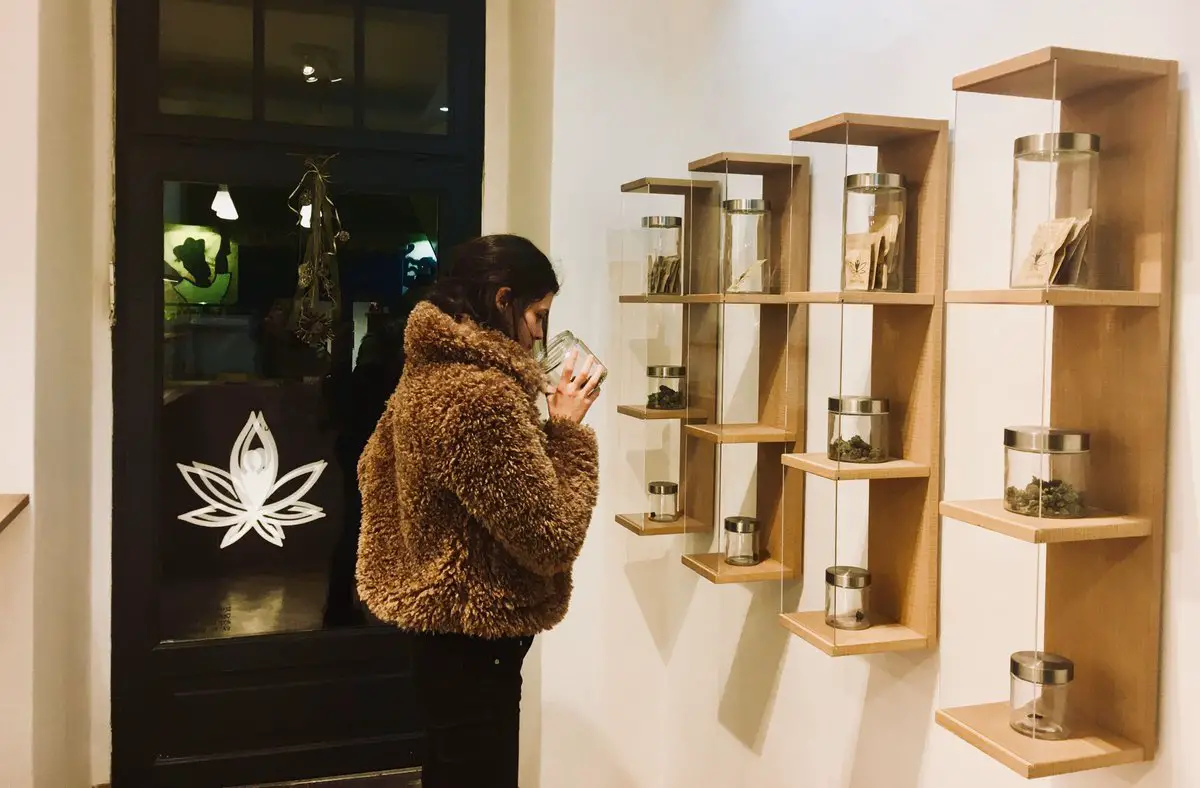
Things to do with children
You can find our Top 12 list of things to do with kids in Ljubljana here. If want to read more about the philosophy behind the wonderful House of Experiments look here, while our trip to the Museum of Illusions is documented here, and there’s always riverside walks, pizza and ice cream. With regard to the latter, take a look at our guide to six places that serve good ice cream in winter.
Mini Teater Ljubljana – The season sees a lot of puppet performances for children, in Slovene, at this theatre not far from Križanke. The English schedule for the month is here.
Ljubljana Puppet Theatre - The puppet theatre near the Central Market and next to the Castle funicular has a full programme or shows, for children and adults, with the schedule here.
LGBT+ Ljubljana
If you want to learn more about Ljubljana Pride, then take a look at our interview with its president here. If you're looking for more general links on "gay Slovenia", including a history of the scene and various projects, then you can find that here, while our stories about the community can be found here. One recent post: Slovenia ranked #28 for LBGT travellers, highest in ex-Yugo
Klub Monokel – This lesbian bar in Metelkova is open every Friday, and this week there’s also a DJ event (hosted with Tiffany, below) with Ustanova • Slikback, A7ba-L-Jelly, and mapalma. You can see and hear Slikback up in the clubbing section, while a set from the fabulously named A7ba-L-Jelly is below.
Klub Tiffany – And the gay bar next door is also open on Fridays, while every Monday until June 2019 there's tango at 18:00. This week, on Thursday evening 19:00 to 23:00, there’s a night of card and table games, while Saturday afternoon (15:00 to 18:00), there’s a workshop on online communication that seems to be aimed at lesbians and feminists, with details here.
Pritličje – This seems to be the only "always open" LGBT-friendly cafe / bar / events space in town, and perhaps the country, so it's a good thing it's such a good one, open from morning to night, and with fliers and posters letting you know what's happening outside the narrow confines of, say, a general interest online what's on... guide.
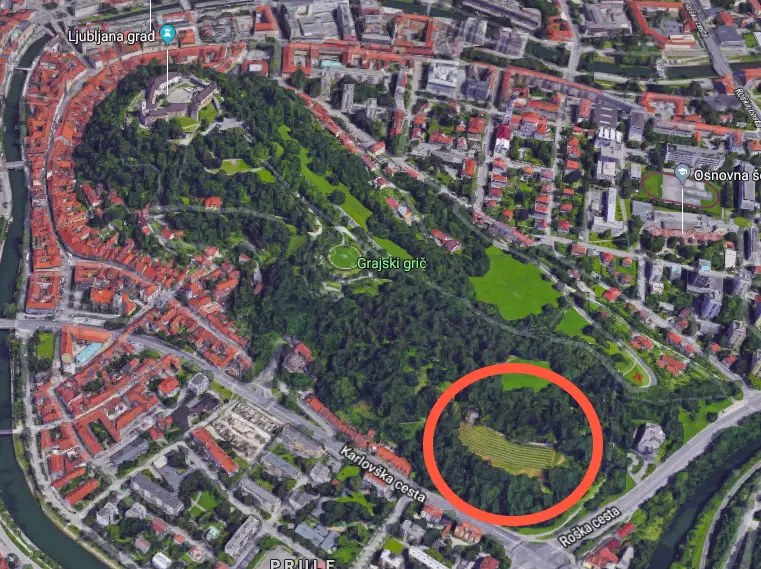
Screenshot from Google Maps, showing the location of the Castle vineyard
Ljubljana Castle
The city’s main attraction is said to be the top tourist draw in the country overall, and to my mind it earns a spot near the top just for the history and views. But beyond that the current owners, the City of Ljubljana, have laid out a varied, interesting and enjoyable programme of events, one that rewards regular revisits.
I try and get up there every Saturday morning to clear my head and move my feet on the trails, and never tire of that end of the hill. At the other end, where the Castle sits, there’s a lot more than fresh air on offer. There are guided tours, restaurants, a café, Castle museum, puppet museum, a Watchtower you can climb to the highest point in the city, art shows, dances, live music, movies under the stars, festival days and more – enough to reward multiple trips up the hill through the year. All of these activities and events can be found on the Castle website, while on TSN you can see “25 things to know about Ljubljana Castle” here, and “Ten Ways to Enjoy Ljubljana Castle” here.
Museums and galleries
Most public galleries and museums are closed on Mondays, although not the National Museum, and - as noted at the start
Plečnik's desk. Photo: JL Flanner
Plečnik’s House is worth a visit if you want to learn more about the architect who gave Ljubljana much of its character, and it's also in a really nice part of town, Trnovo, just a short walk or cycle upriver. Read about our guided tour here.
Balassi Institute – The Hungarian culture centre has an exhibition entitled “Encounters in Visual Art” introduces works of selected visual artists, painters and sculptors, who define today's art scene in Hungary and Slovenia, as promoted with the image below. Free to enter, this venue is next to a Spar and Hofer, and not far from Dragon Bridge, and always has something interesting going on. Learn more here.
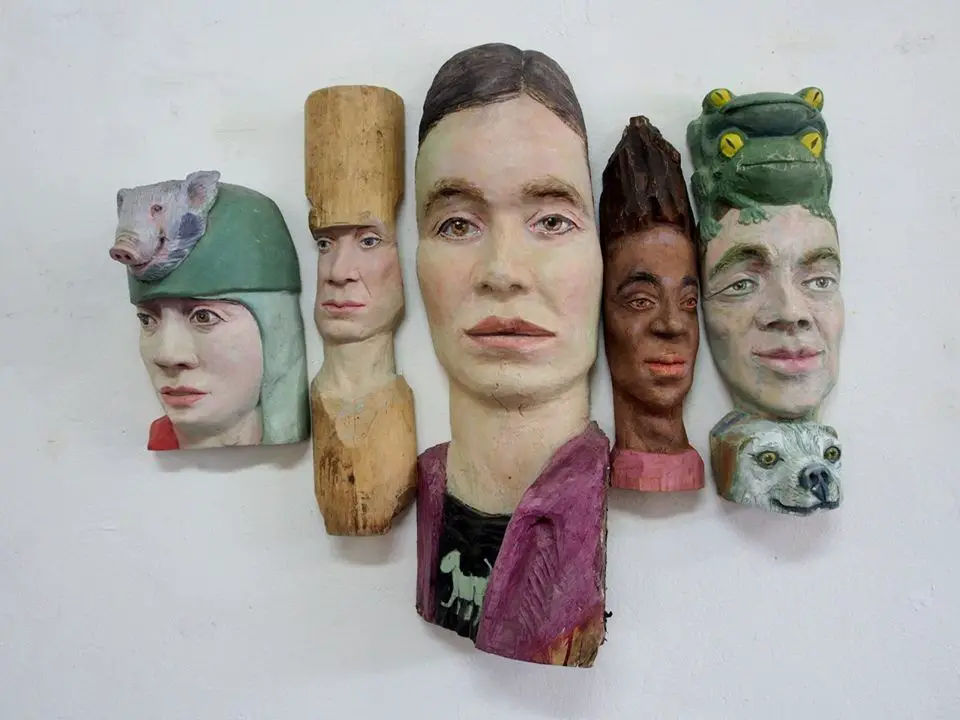
Cankerjev dom – Showing until the end of March is a selection of specimens (in Slovene, English and other languages) from The Newspaper Museum, while there are also some architectural models and plans on display.
City Museum – The Museum in French Revolution Square an interesting permanent exhibition on the history of Ljubljana, from prehistoric times to the present day, with many artefacts, models and so on that bring the story alive.You can read about my visit here.
The Faces of Ljubljana in the City Museum. Photo: JL Flanner
City Gallery - Not far from the Robba Fountain and running until March 24 is a show presenting drawings by Iztok Sitar, the original pages that were used to make his graphic novels over the last three decades. Rather adult in nature – think Robert Crumb in terms of sex, drugs and religion, in places – it’s free to enter and has much to enjoy. One of the pictures I took on my visit is below.
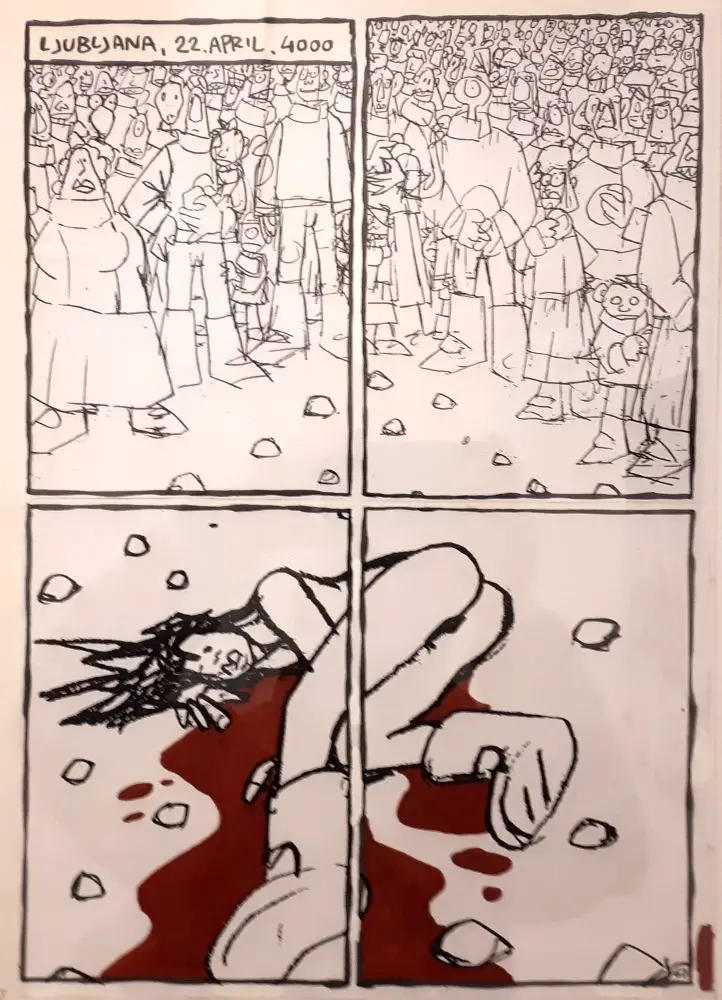
Photo: JL Flanner
MAO – The Museum of Architecture and Design has much of what you'd expect, and until March 25, 2019, has a show on Ljubljana and it's relation with water.
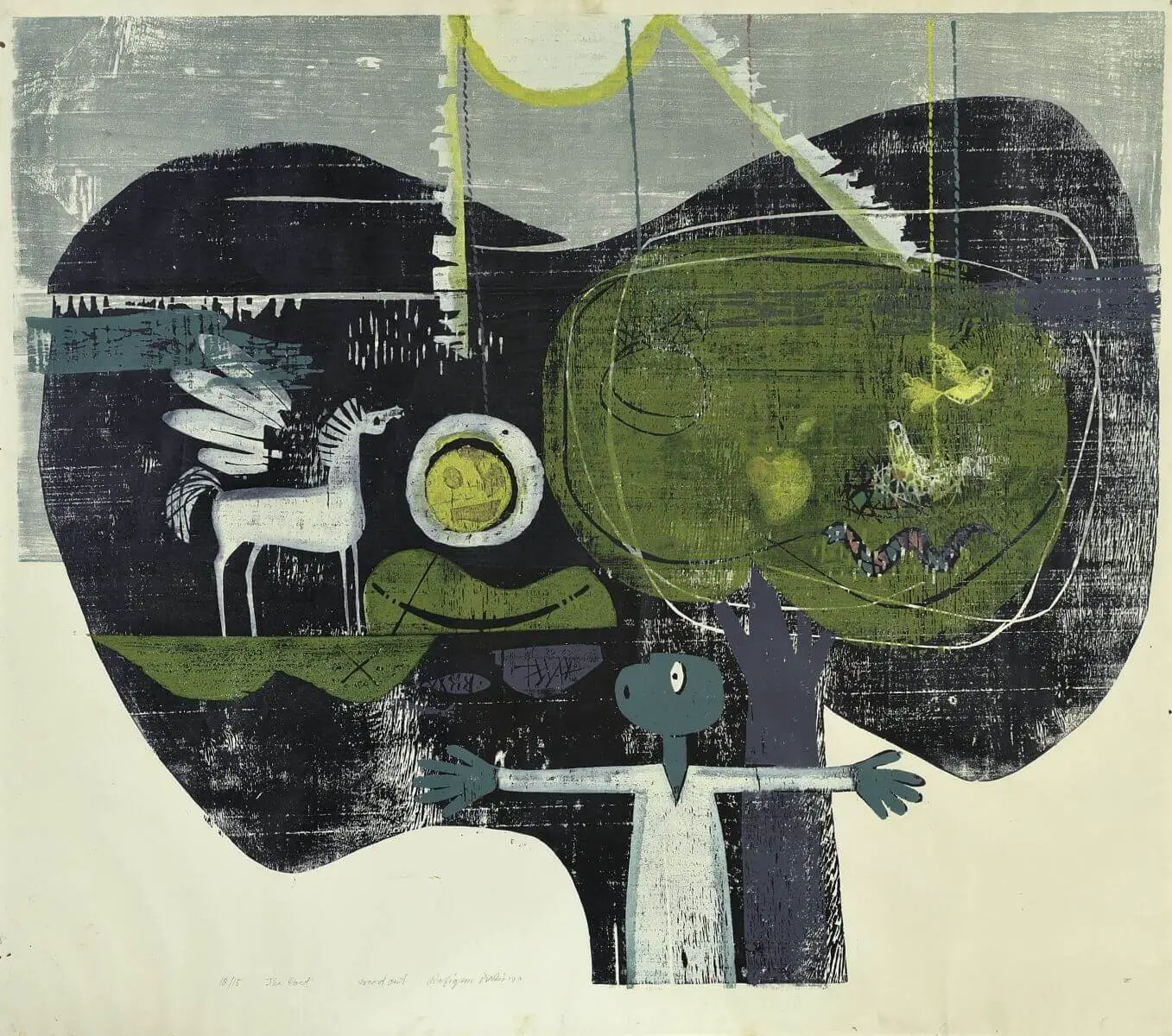
Rafikun Nabi: Poet, 1980, print, 96.5 x 110 cm. Courtesy of the Contemporary Art Center of Montenegro. On display at the Metelova branch of the Moderna galerija
Moderna galerija – The main branch of this gallery, to be found near the entrance to Tivoli Park, has a good collection of modern art, as well a nice café in the basement. Running until March 31 is a major show on young Slovenian painters, Time Without Innocence – Recent Painting in Slovenia, where you’ll see works like the following. You can read about my visit here (I loved it). The museum's Metelkova branch also has a big new show, runing until at least September 2019, an the art of the Non-Aligned Movement, with an example shown above.
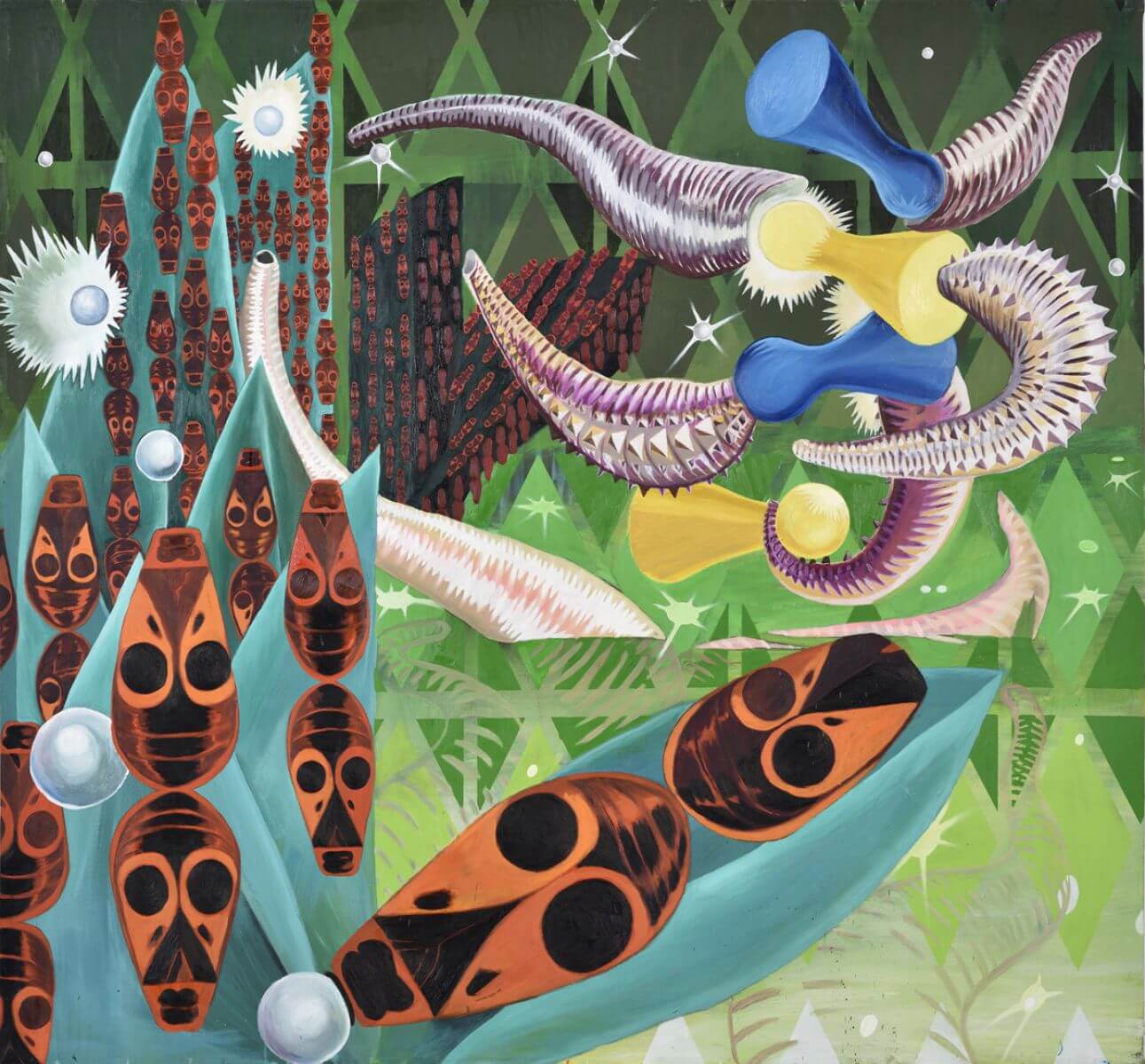
Iva Tratnik, Mating Season Totalitarianism, 2014, oil on canvas, 210 x 194 cm
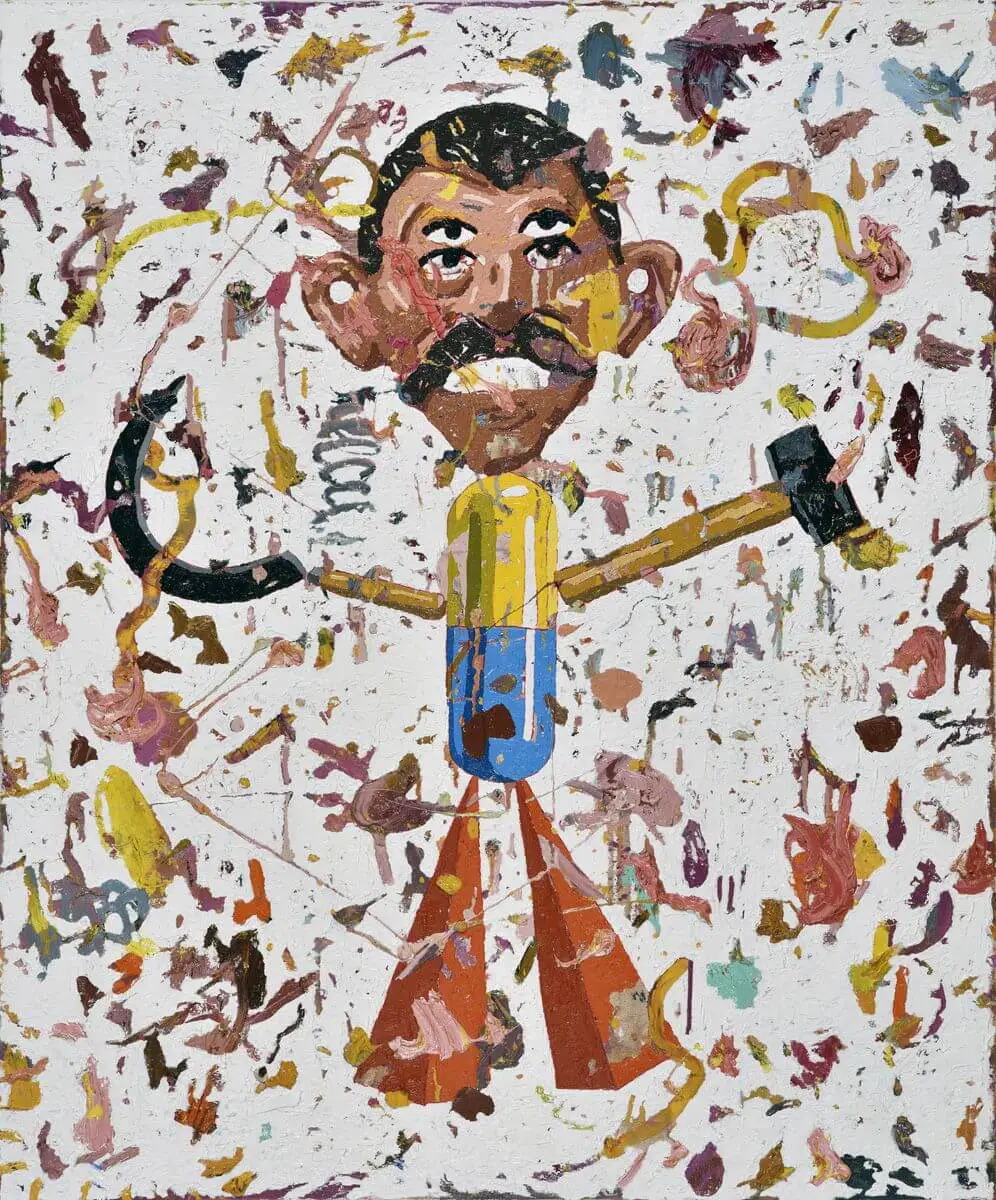
Arjan Pregl, from the Carnival series, oil on canvas (6 paintings 120 x 100 cm; 3 paintings 80 x 60 cm), 2018. Mr Pregl was recently voted "worse than Hitler" on Twitter.
National Gallery – The country’s main gallery has “the best” of what’s on offer from the Middle Ages to non-contemporary modern visual arts, and is in a great location for exploring other areas, just by Tivoli Park and opposite the main branch of the Moderna galerija. You can read about our visit to the room containing sacred art from the Middle Ages here.
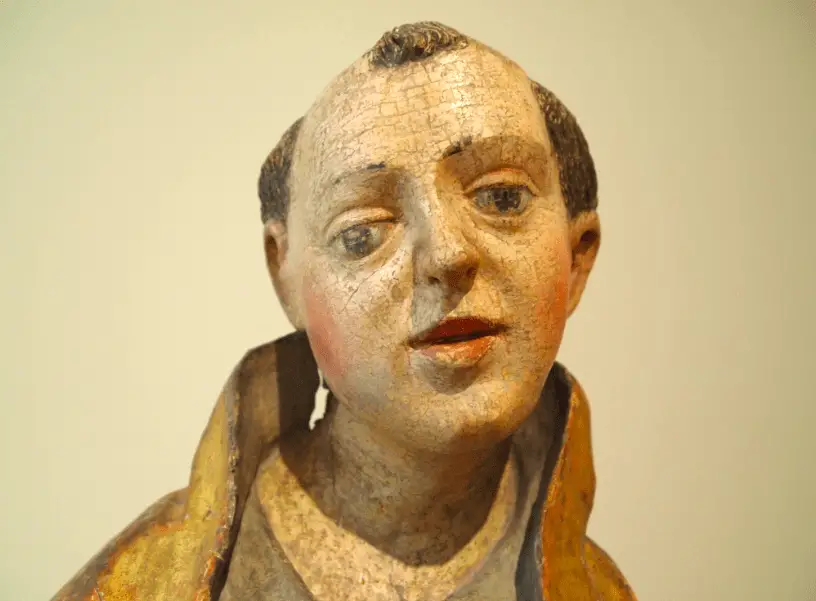
JL Flanner
The real Robba Fountain can be found in the entrance to the National Gallery - the one you see in the Old Town is a genuine fake, as seen below and reported here.
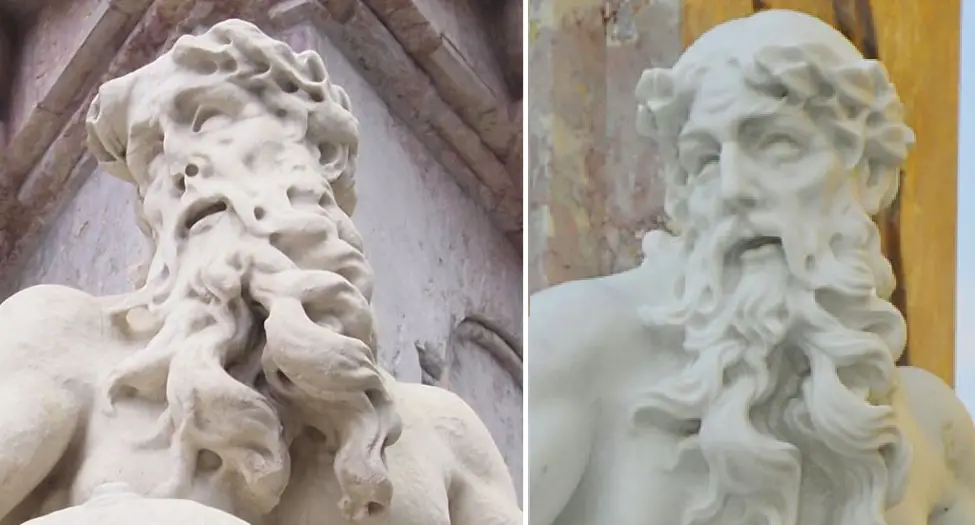
Photo: JL Flanner
National Museum of Slovenia – There’s plenty to see in the permanent collection here, from Roman times, Egypt and more. Meanwhile, the museum's Metelkova branch, located between one branch of the Moderna galerija and the Ethnographic Museum has some rooms on Church art, furniture and weapons, with the latter including more guns than you'll see anywhere else in town, and quite a thrill if coming from a nation where such objects are not household items.
Natural History Museum – On until the end of June 2019 is Our Little Big Sea, which takes a look at the oceans.
Slovene Ethnographic Museum – The museum currently has a temporary show on Bees and Beekeeping, on until June 16 2019, as well two permanent exhibitions. One of these is called Between Nature and Culture, and has a great collection of objects from Slovenia and around the world, well worth the trip up to the third floor to see it (as recounted here). This place is located near the newer branch of the Moderna galerija and Metelkova.
Union is "the Ljubljana beer", but now both it and Laško are owned by Heineken. There are many local brews on offer around town, though, if you want to explore IPAs, stouts, wheatbeers, sours and so on Photo: JL Flanner
Union Experience – The Ljubljana-based brewer has a museum showing the history of the company, with the ticket also including access to part of the factory and a few samples of the product. You can read about our visit here.
It's not a formal museum, but if you're interested in "Yugo-stalgia" then you'll enjoy a trip to Verba, a small, privately run space that's crammed with objects and pop culture items from the era, and is conveniently located at the start of one of the short walks to the castle. It's also a great place to take pictures, if you leave a donation, and you can read more about it here.
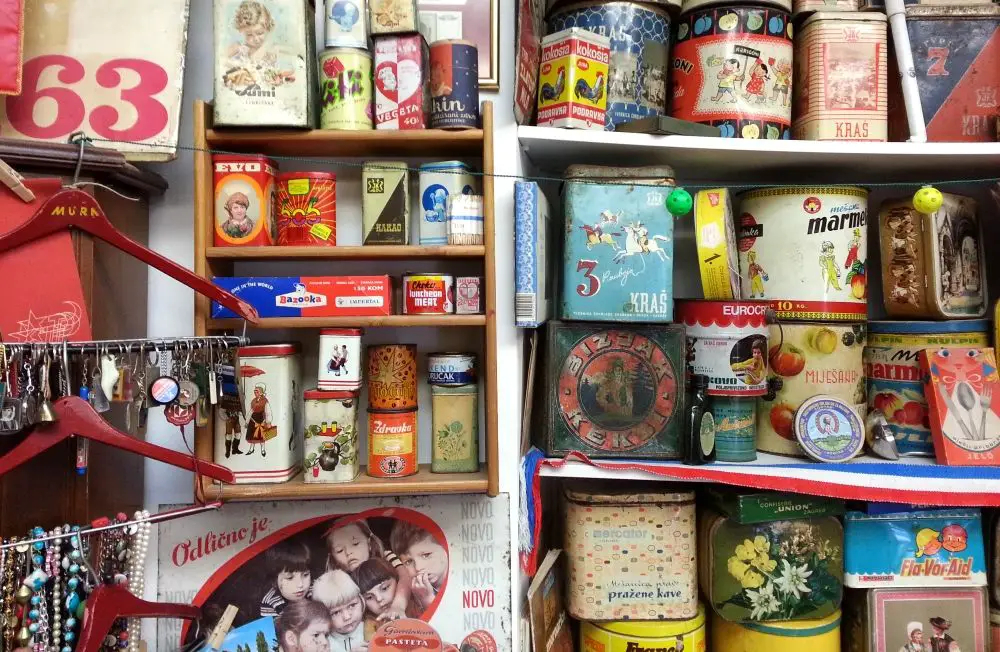
Verba. Photo: JL Flanner
Alternative Ljubljana isn't a museum or gallery, as such, but instead turns the city streets into a museum and gallery. Learn more about their tours of street art, history and LGBT Ljubljana here.
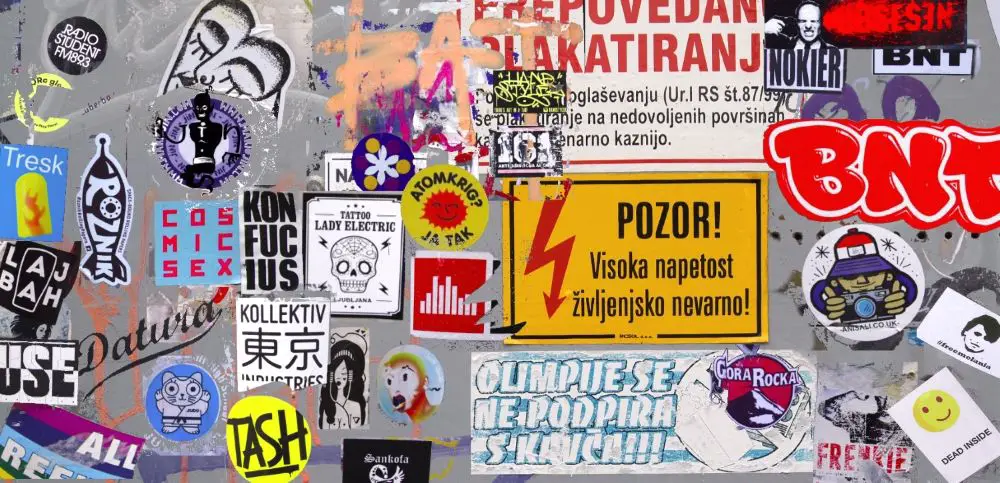
Photo: JL Flanner
Other things to do in Ljubljana
If you'd like to spend an evening painting with others, then take a look at Design with Wine, which organises painting parties on Trubarjeva cesta,
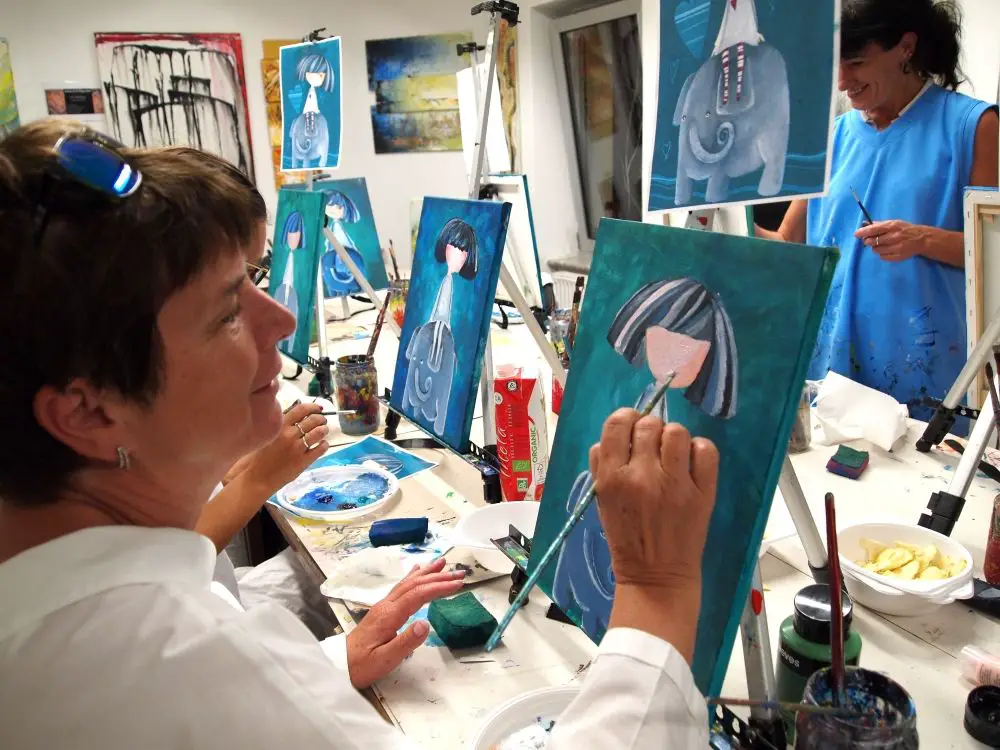
If you want to see some antiques, then check out the wonderful Antika Carniola, as discussed here. The man behind it, Jaka Prijatelj, has a fine eye for life on this street, as you can see on his Facebook account.
Photo: JL Flanner
If you’re in town and want to go jogging or walking in nature, why not take another look at the Castle, with a brief guide to the trails here. If you want something bigger, head to Tivoli Park.
And if you're bored with the Old Town, why not take a walk, cycle or boat ride to nearby Špica and enjoy the riverside life. Learn more about that here.
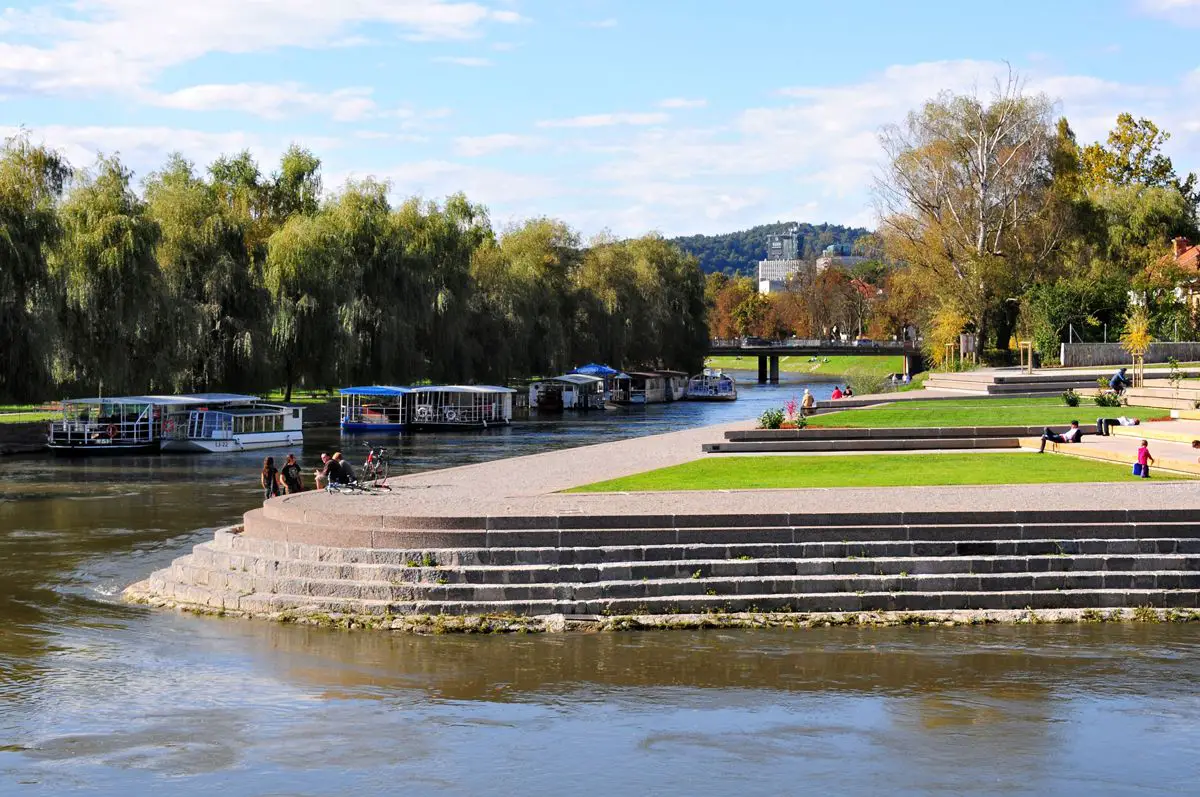
visitljubjana.si
![]()
maxpixel.net, public domain
Want to stretch and breath? Then check out our list of drop-in yoga classes for tourists, visitors and the uncommitted. If you're heading to the coast, check out our interview with a yoga teacher who offers breakfast sessions there, while if you're staying in town (or nearby) and want to try some "family yoga" then you can learn more about that here and maybe get your kids to calm down a moment or two.
There are some golf courses near Ljubljana, but even ones further away are not far, as seen in our list of all the golf courses in Slovenia. Note that these close when the snow starts, if it ever does this year, in which case you might be interested in what's new at Slovenia's ski resorts for 2019, as reported here.
![]()
Photo: maxpixel.net, public domain
Daytrips
Most of Slovenia is only a few hours from Ljubljana, and you can easily visit Lake Bled, Lipica Stud Farm, Postojna Cave, Predjama Castle, the coast and other locations, while if you'd like to take a photo of from that bench in Bled, then you can learn how to get there here. If you’re looking for something more ambitious, then check out our recent guide to the 17 members of the Association of Historical Towns of Slovenia
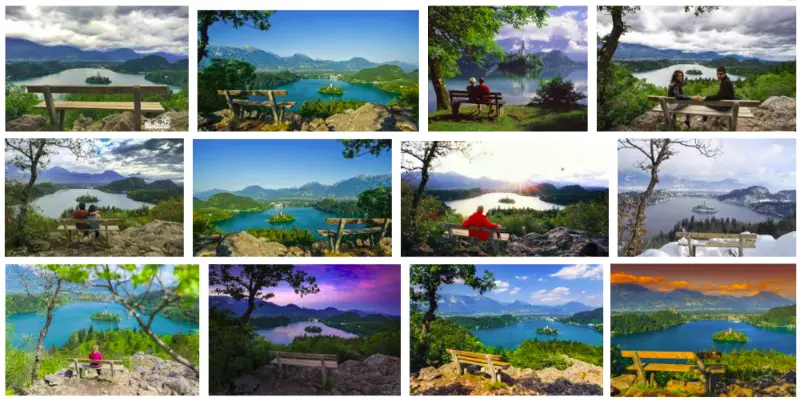
Photo: Google Image Search
Getting around
If you want to get a Ljubljana Tourist Card, which gives you travel on the city buses and entry to a lot of attractions, then you can read more about that here, and if you want to use the bike share system, as useful for visitors as it is for residents, then you can learn more by clicking this. Visitors with reduced mobility will be pleased to find that downtown Ljubljana is generally rated as good with regard to accessibility, and that there’s a free, city-sponsored app called Ljubljana by Wheelchair highlighting cafés, attractions and so on with ramps, disabled bathrooms and Eurokey facilities, which you can read about and download here. Manual wheelchair users can also borrow, for free, an attachment that will motorise their equipment, as reported here.
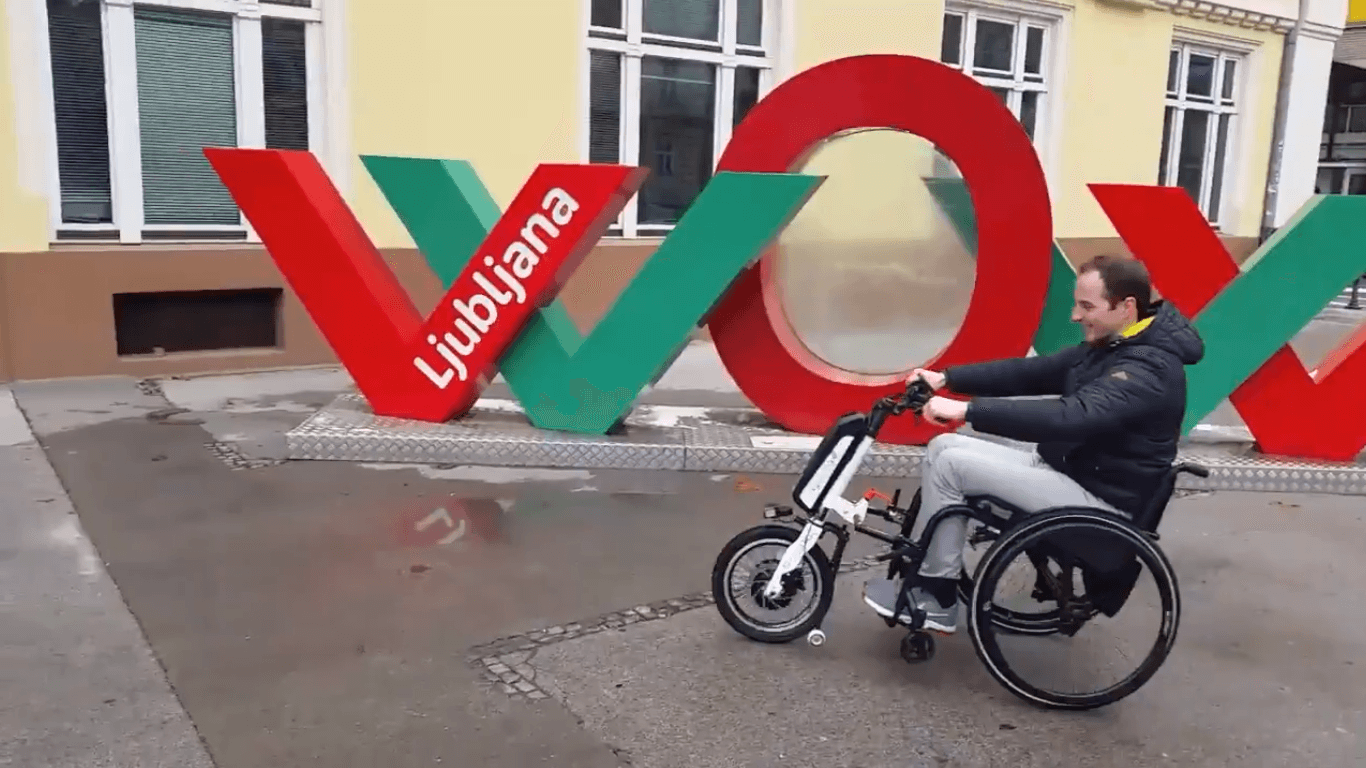
Screenshot from a Twitter video
If you’re driving into town and don’t know where to part, our guide to how to park in Ljubljana is here.
There aren't many places to eat after midnight, and most of them are by the train station, as reported here.
Want / need cigarettes but the stores have closed? Here's an incomplete list of bars downtown that will satisfy your craving for the demon weed. While if you’re having trouble with the ATMs then here’s a guide to the Slovene you’ll see on screen. If you get a hangover then find out where to get paracetamol (and prescription drugs) in Ljubljana here, while details on emergency birth control can be found here.
Ljubljana is a small and relatively safe city, but if need to contact the police then there’s a special number for foreigners, and that’s 113.
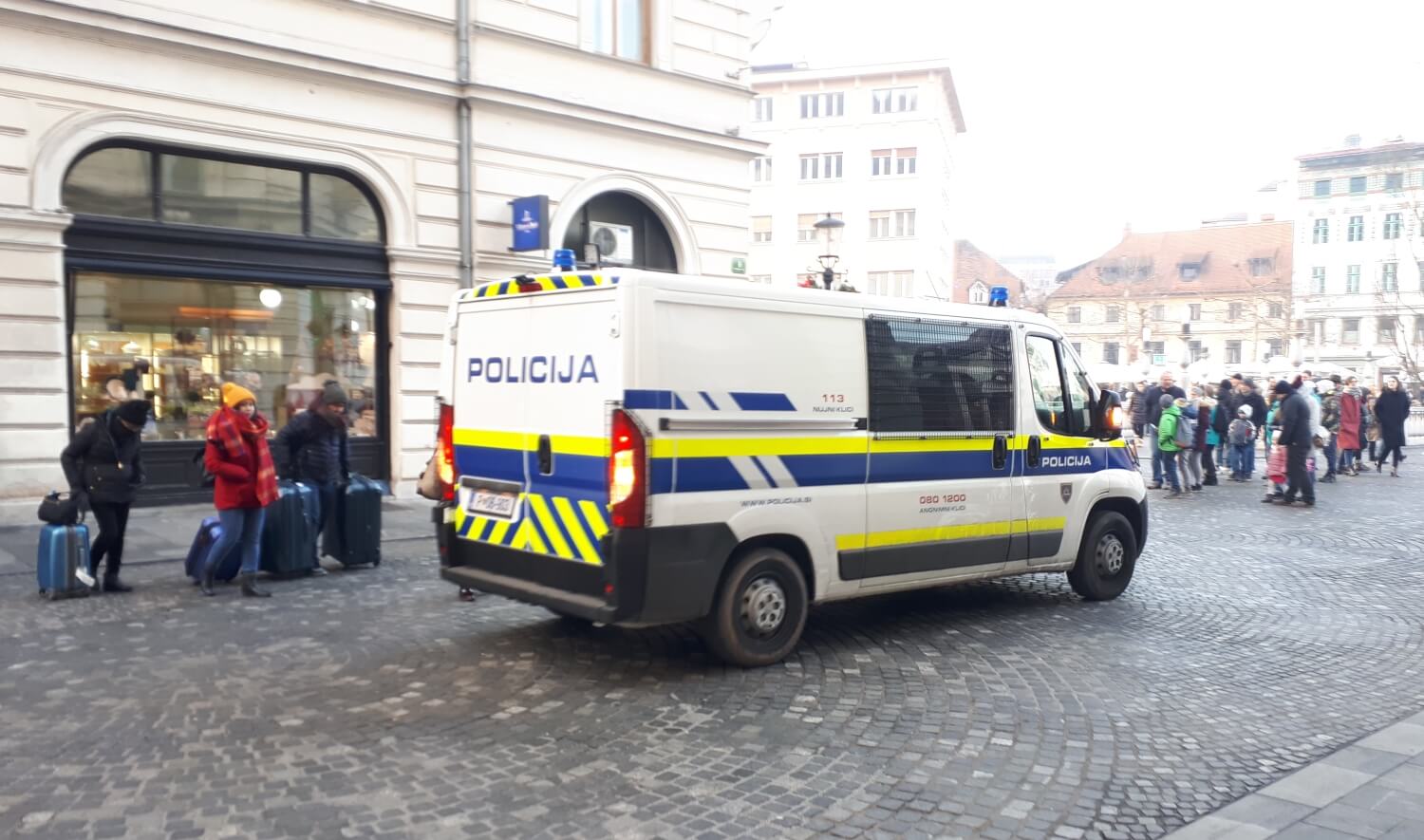
Photo: JL Flanner
STA, 7 March 2019 - A statement by children's doctor and psychotherapist Viljem Ščuka equating sex and rape has been declared the most sexist statement of 2018 by the organisers of feminist and queer festival Red Dawns.
"Mass rapes of girls (schoolmates) are not possible if girls are against. Both participants are responsible for sexual intercourse because it takes place with both being fully conscious ..."
Ščuka, 80, made the statement for the news portal Svet24 commenting on a former teacher's proposal about how to tackle problematic, violent primary school children.
It earned him the Silver Thistle title, which is conferred annually to raise awareness about sexist statements which are usually overlooked.
"This dishonourable title is given to those who publicly attack, humiliate or offend others on the basis of sex, sexual orientation and/or sexual identity," according to the festival's website.
The citation of the Silver Thistle said Ščuka's statement "equalises sexual intercourse with sexual violence and shifts responsibility for violence onto victims, which is not only unacceptable but also dangerous".
It added it was hard to understand anyone would think rape takes place with the victim's consent and even harder if such a statement was made publicly by an expert.
The Silver Thistle is given out on the basis of an online vote by the editorial board of spol.si, a news portal focussing on gender issues, and the Red Dawns collective, which organises the festival of the same name.
The most sexist statement of last year was declared Wednesday evening.
Last year, the dishonourable title went to acclaimed jurist Boštjan M. Zupančič, who labelled French politician Simone Veil (1927-1979) a murderer for allowing abortion.
https://www.total-slovenia-news.com/lifestyle/748-slovenia-s-most-sexist-statement-of-the-year-award
STA, 6 March 2019 - A campaign urging people to abstain from alcohol for the next 40 days until Easter started on Wednesday for the 14th year running, reminding the public of the dangers of alcohol consumption.
The campaign, instigated by Slovenian Caritas, the Slovenian Traffic Safety Agency, and the prevention organisation Med.Over.Net Institute, is running under the slogan "For a responsible drinking culture".
It encourages a responsible attitude towards drinking "at home, on the roads, at work, in company or wherever", secretary general of Slovenian Caritas Cveto Uršič told reporters.
The campaign, coinciding with the Catholic period of Lent, supports everybody who is suffering due to the negative effects of alcohol consumption such as violence, accidents, or health problems.
Uršič pointed out the "extremely cruel" statistics in terms of alcohol consumption. At least 1,000 people on average die every year because of alcohol-related reasons. In the last five years, drink driving caused 7,907 traffic accidents in Slovenia, 157 deaths and 732 gravely injured.
"Alcohol often leads to domestic violence, workplace violence, and bullying. It can also result in unemployment and poverty or is caused by them," Uršič said.
The representative of Med.Over.Net Institution, Andreja Verovšek, stressed that giving up alcohol was a decision demanding a lot of persistence and support.
According to the National Institute of Public Health's (NIJZ) data, almost half of Slovenians between 25 and 64 years of age (43%) consume too much alcohol, crossing the recommended consumption limit.
Alcohol-related costs to Slovenia's health system for the period between 2012 and 2016 are estimated at EUR 147m per year. Including all other related costs, such as the ones caused by accidents and domestic violence, the estimate rises to EUR 228m.
The ambassador of this year's campaign, journalist and presenter Igor E. Bergant, said the campaign raised awareness of a major social problem, as well as sent a positive message of educating instead of judging.
He stressed the importance of a zero-tolerance policy while driving or working, and the importance of being a role model for children. Bergant also acknowledged that Slovenia's stance on alcohol consumption had always been over-tolerant and therefore problematic.
Slovenian Caritas has included older pupils of primary schools and high school students in the campaign, inviting them to contribute to the prevention project with their own ideas and creations. They were encouraged to consider maintaining relationships, health, prosperity, and fun without alcohol and other drugs.
All our stories about alcohol abuse and Slovenia can be found here
https://www.total-slovenia-news.com/travel/3147-gay-slovenia-ranked-28-for-lgbt-travellers-highest-in-ex-yugo
Yesterday, March 6, saw the official start of the Red Dawns International Feminist & Queer Festival, which offers several days of events, exhibitions, discussions and concerts to bring people together for art and activism. The full programme for the event, in English, can be found here, while the Facebook page is here.
One large event, not strictly part of the festival but surely related, will be the Women’s Day march that’ll take place on Friday (08/03), starting at 17:00 in Congress Square (Kongresni trg), the main square downtown that’s also home to Zvezda Park.
All our stories about LGBT+ issues and Slovenia can be found here
The human capacity to do harm, both mental and physical, to fellow humans boggles the mind. This has manifested itself in innumerable forms over the millennia, from the cliché of the pre-modern world of overt corporeal punishment as a deterrent to onlookers (who found it more entertaining spectacle then rationale not to commit punishable offenses) to the Enlightenment and 19th century shift to a psychological preventative (and one might say brainwashing approach) to deterring crime. There is no other animal we know of who willfully, proactively, and strategically tries to torture its fellow species, or mess with their minds in a form of psychological torture. We humans are special, and not only in positive respects.
The chapter of human penal history dealt with in this book is very little known in Anglophone circles, and only superficially known in former Yugoslavia ones. Yugoslavs will have heard of the infamous prison island called “Bald Island,” Goli Otok (pronounced “goalie oh tok”) but few know more than a sentence or two of explanation. And yet it was a very important location in the history of surveillance, secret policing and intelligence gathering, and was a key for Tito and his Yugoslavia, as a looming threat to keep dissenters, which in this case meant potential pro-Stalinists, in line. Tito has long been considered by Western history students as a “good socialist” (with the implication that socialists and communists were, as a group, “bad”). He was certainly a political genius, able to single-handedly hold together, even if by the grip of his fingernails, the many diverse and combative republics of former Yugoslavia. He knew that as soon as he died or relinquished power to completely, Yugoslavia would implode. By his sheer will, strength and charisma he was able to hold it together. Indeed, Yugoslavia did erupt into a horrid civil war, replete with ethnic cleansing, shortly after he passed. But Tito was also possessed of a dark side, for all the impressive and laudable things that he did. Some historians have argued that his level of iron-fistedness was as little as he could get away with, while still maintaining power and authority. There may be something to this. He was not a sociopath, making him a very different creature from Stalin and Hitler. But he did imprison and kill his own people, and he did resort to inhumane methods, though within the context of world leaders he was among the most humane and worked the hardest for the collective good of this people. The same cannot be said for so many of his comparable protagonists.
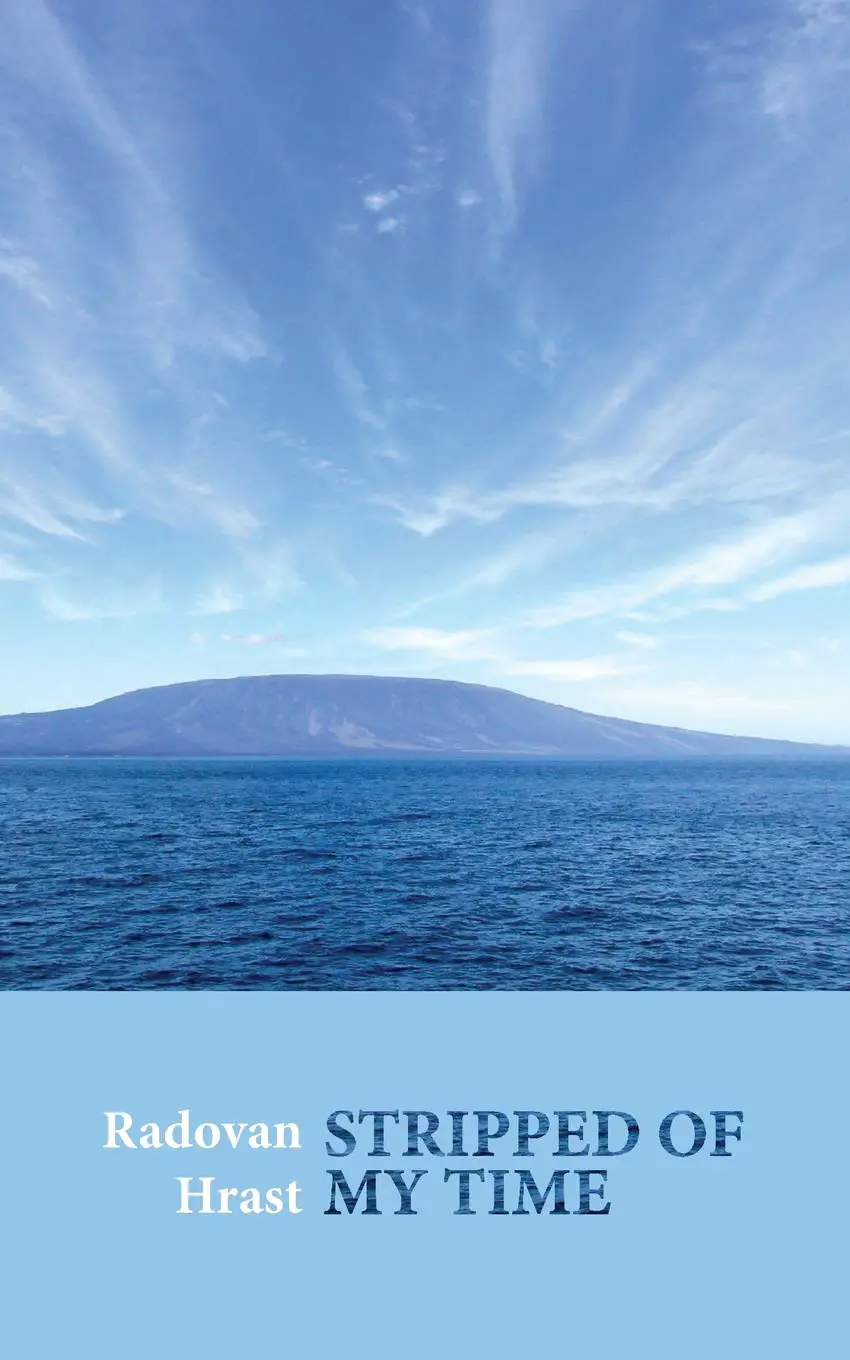
His darkest blot is surely Goli Otok, and this book is the definitive insider account of what life, if you can call it that, was like on the “Yugoslav Gulag.”
The author of a memoir, Stripped of My Time: A Survivor of the Communist Prison on Goli Otok, Radovan Hrast, contacted me in a most unusual way. He showed up at my front door, out of the blue, at the age of 85, after having read an article about me in some newspaper or other. As the only American writer and historian living as an expat in Slovenia, he saw in me someone who might help him give voice in an anglophone outlet to his story. His memoir was originally published decades ago in Slovenian, at first in a thick edition, and later in a more slender one. It is this more slender edition that you hold in your hands now, translated for the first time into English.
Radovan is a ray of sunshine. This is the first thought that strikes just about anyone who meets him. He is also now nearly 90, and the combination of being so peppy, bubbly and enthusiastic, cut with his advanced age, makes me want to know what is in his secret sauce. He is a man of great emotion and loyalty and deep thought, though set against his background, which he repeatedly describes as a life “without schooling.” What his prose may lack in grammatical consistencies and grace notes, it more than makes up for in honesty, detail, a razor-sharp memory and one heck of a story. Radovan’s main claim to fame is that he survived internment, twice, on Goli Otok.
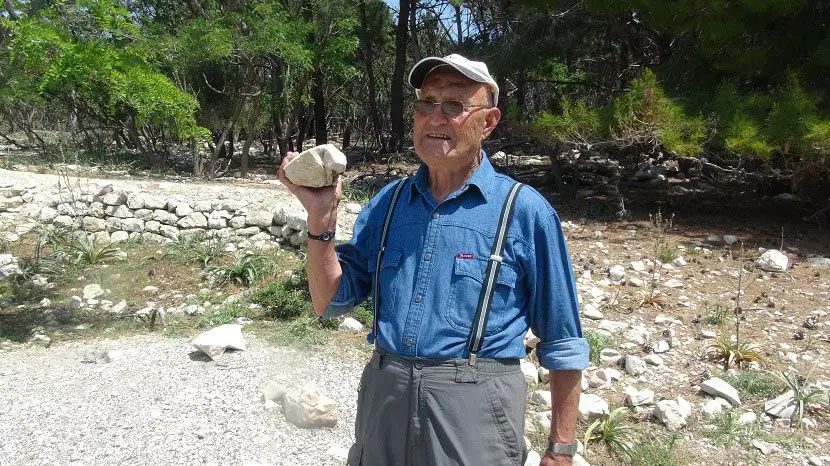
Radovan Hrast
Located just off the Dalmatian coast, Goli Otok was considered the harshest prison environment for Yugoslavs who were not toeing the line. It was almost exclusively for citizens who got into trouble (military officials, politicians, foreigners and women were imprisoned elsewhere). It was home to a bizarre but calculated series of rituals designed to make the fellow prisoners act as jailers, torturers and intimidator for their fellow inmates. There, prisoners were given no time to rest, no time to think, and were forced to attack one another on a daily basis, which had the effect of preventing possible bonding and conspiratorial attempts to escape. Radovan was one of the first inmates there, sent for a trifle while still a teenager. When he got out, he was double-crossed and sent back. Those sent for a second time were subject to an increasingly brutal regime, and it is a small miracle that Radovan survived. It is a giant miracle that he flourished and lived out the rest of his life as a happy, fulfilled person unaccompanied by what would be understand rage and the urge for vengeance.
This book should surely take its place on the shelves of every history library and make the reading list for all students of 20th century history and political science, especially those who deal with Yugoslavia and the aftermath of the Second World War. One would think that a man who lost years of his life unjustly would be bitter and vengeful and bear a broken spirit. Nothing of the sort. He is the most enthusiastic, kind and effervescent octogenarian one could imagine. I was delighted to guide him through the process of publishing his book, which I was certain that any good history press would snap up immediately. But because of his advanced age, understandably was wary about waiting the months to more than a year that it would take to shop for a press based on a book proposal, wait for acceptance, then work the many drafts with editor. Radovan does not know how to use a computer and has, of course, no email, so the logistics of dealing with a formal publisher were impossible. In the interests of time, I set him up with a great translator, a great designer and helped him to self-publish. His only goal is to make his story available as widely as possible. And now, here it is. We are grateful for the chance to preserve this story of horror and ultimate triumph of the human spirit.
Buy Stripped of My Time: A Survivor of the Communist Prison on Goli Otokon Amazon
As part of the US Embassy’s programme to encourage cultural exchanges between the US and Slovenia, the town of Kamnik will see a series of free events, no registration required, starting this Friday, March 8, to be held at Samostan Mekinje (the Mekinje Monastery).
This will see the renowned American artist and writer Manuel Gonzalez and photographer Jesse Burke making appearances and presenting workshops for the general public. Kamnik resident and Slovenologist Noah Charney is also involved, and will be interviewing the visitors.
More details are below, as taken from the related website (with the calendar in Slovene only):
Program:
Friday, March 8th
11.00 Opening of the photographic exhibition by Jesse Burke in the lobby of the Municipality of Kamnik (by the Mayor Matej Slapar) and a guided tour of the exhibition (Jesse Burke)
18.00 Interview with photographer Jesse Burke in the Mekinje Monastery (led by Noah Charney)
Saturday, March 9th
18.00 Press conference for the presentation of the project and both artists, with a tasting of American food at the Mekinje Monastery
19.00 Public reading and interview with the writer Manuel Gonzales at the Mekinje Monastery (led by Noah Charney)
Monday, March 11th
18.00 Workshop on creative writing at the Mekinje Monastery (Manuel Gonzales)
Tuesday, March 12th
17.00 Workshop on creative writing for young people from the age of 13 in the Library of France Manuel Gonzales,
Wednesday, March 13th
18.00 Workshop on photography in the Mekinje Monastery (Jesse Burke)
If you'd like to learn more about the programme supporting these visits, and perhaps apply for a grant of up to US$10,000, then you can do so here
STA, 4 March 2019 - Iranian journalist, blogger and human rights activist Shiva Nazar Ahari, has found refuge in Slovenia under the ICORN programme. "I'm very happy and grateful that you've accepted me. I've found my peace and freedom here," she told a press conference in Ljubljana.
The press conference was hosted by the Mira women's section of the Slovenian PEN centre ahead of International Women's Day.
The 34-year-old Iranian has been residing in Ljubljana for four months under the International Cities of Refuge Network (ICORN) programme, in which cities and regions offers shelter to writers, journalists and artists at risk of persecution.
The Tehran native has been reporting on various social topics in Iran, including child labour, treatment of political prisoner, extreme poverty and women's rights, Mira president Tanja Tuma said at the presentation.
Nazar Ahari has published articles in prominent web portals and has also been writing for the Committee of Human Rights Reporters, of which she is a founding member. She also had a blog, which is now closed.
She has received numerous awards and accolades, including the inaugural Advocate Behind Bars award in 2012 by the American Islamic Congress.
Nazar Ahari was imprisoned in 2009 by the Iranian authorities for organising a campaign with several other activists for demanding that presidential election pay attention to women's rights.
Accused of "waging war against God", she was sentenced to six years in prison but was released after less than a year under pressure from international organisations, including PEN International.
"I felt that I needed fresh air. I was actually also somewhat disappointed and tired," Nazar Ahari said, adding that she was leaving Iran in a very difficult economic situation.
The situation is deteriorating because of international sanctions, food is getting more expensive every day, people live in fear and are worried about the future, there are no human rights, let alone democracy, she said.
"I'm happy that I have the opportunity to be in Ljubljana. I don't believe that any other city would provide me such peace in this period," added Nazar Ahari.
March 4, 2019
Although the whole point of masquerade is to scare the winter away, it was precisely the warm weather that made this Pust weekend so successful this year. Saturday morning was extremely pleasant in Ljubljana, as you can see from the pictures below, with locals in costumes cheering the visiting masks in a parade.
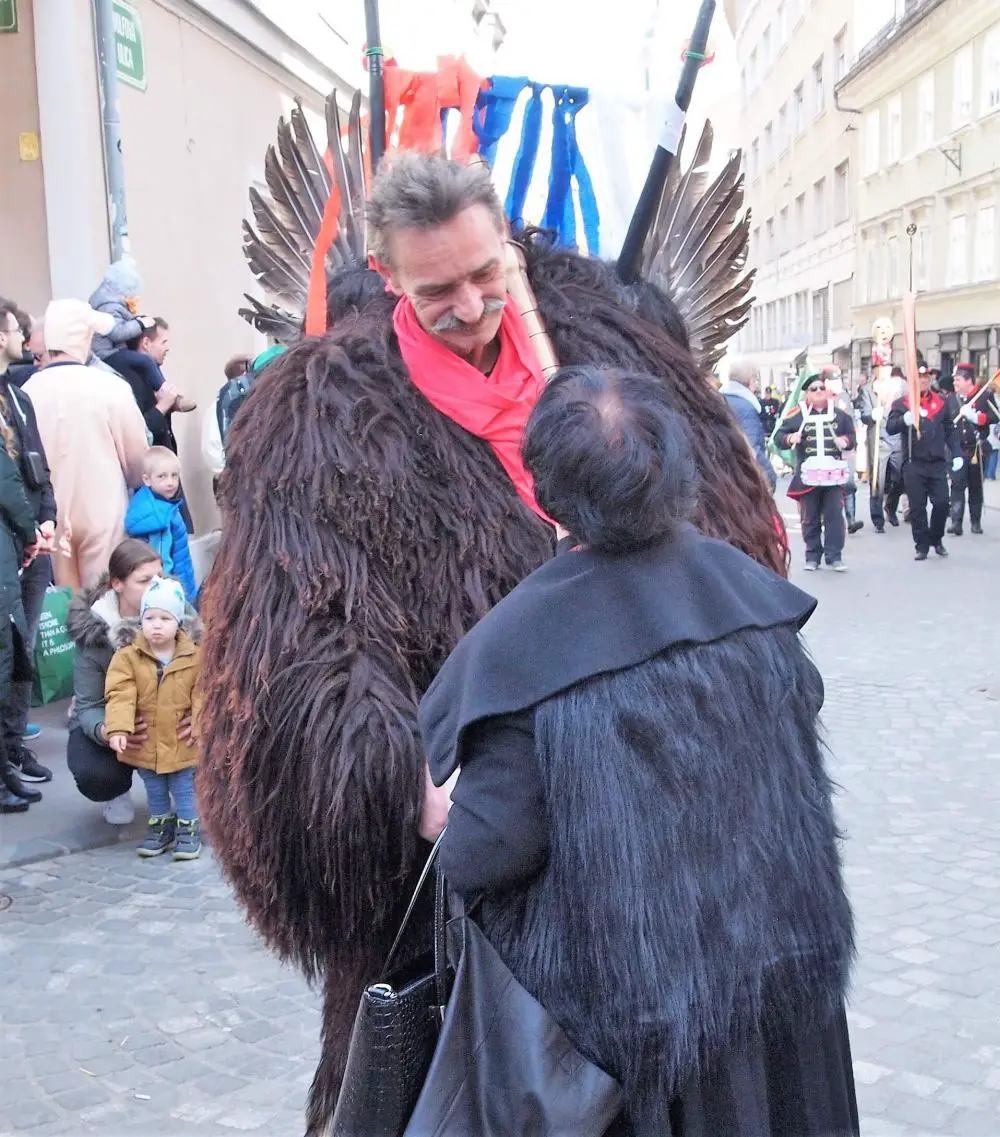
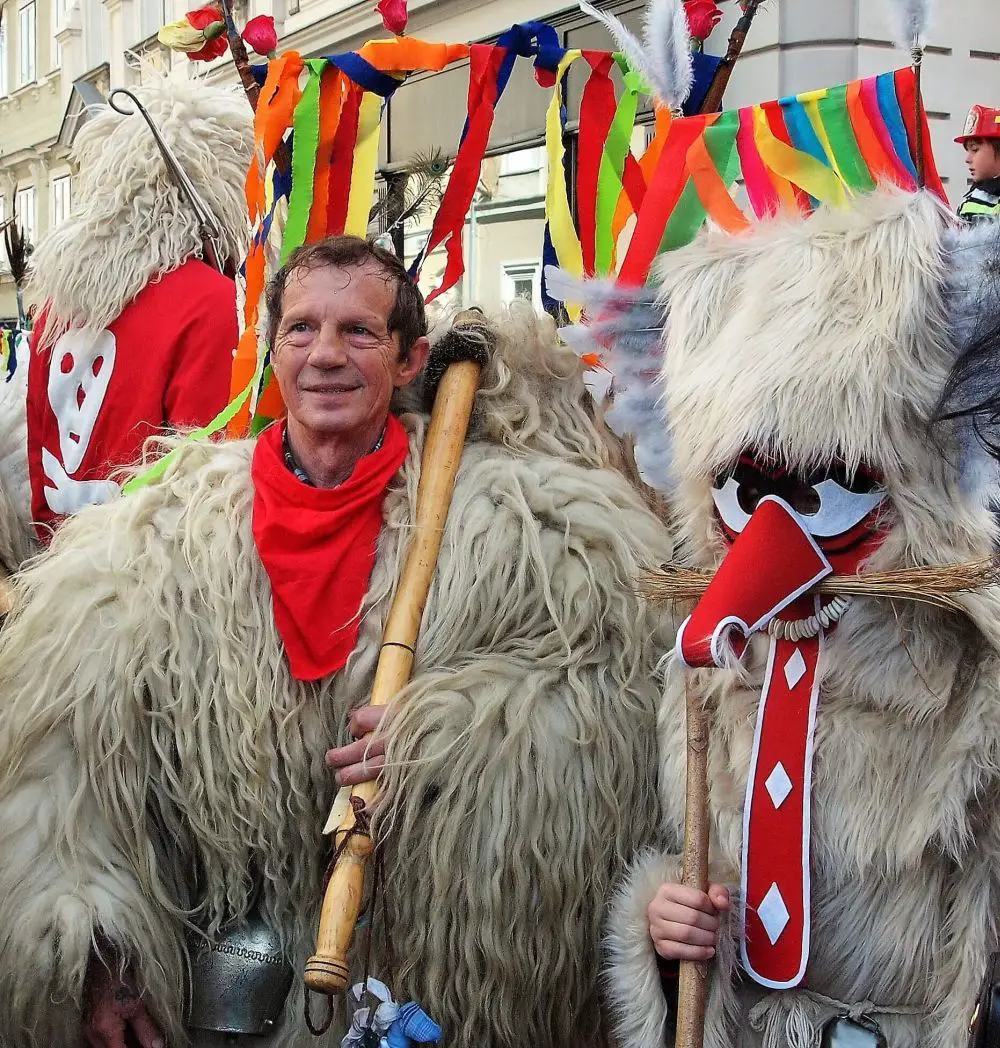
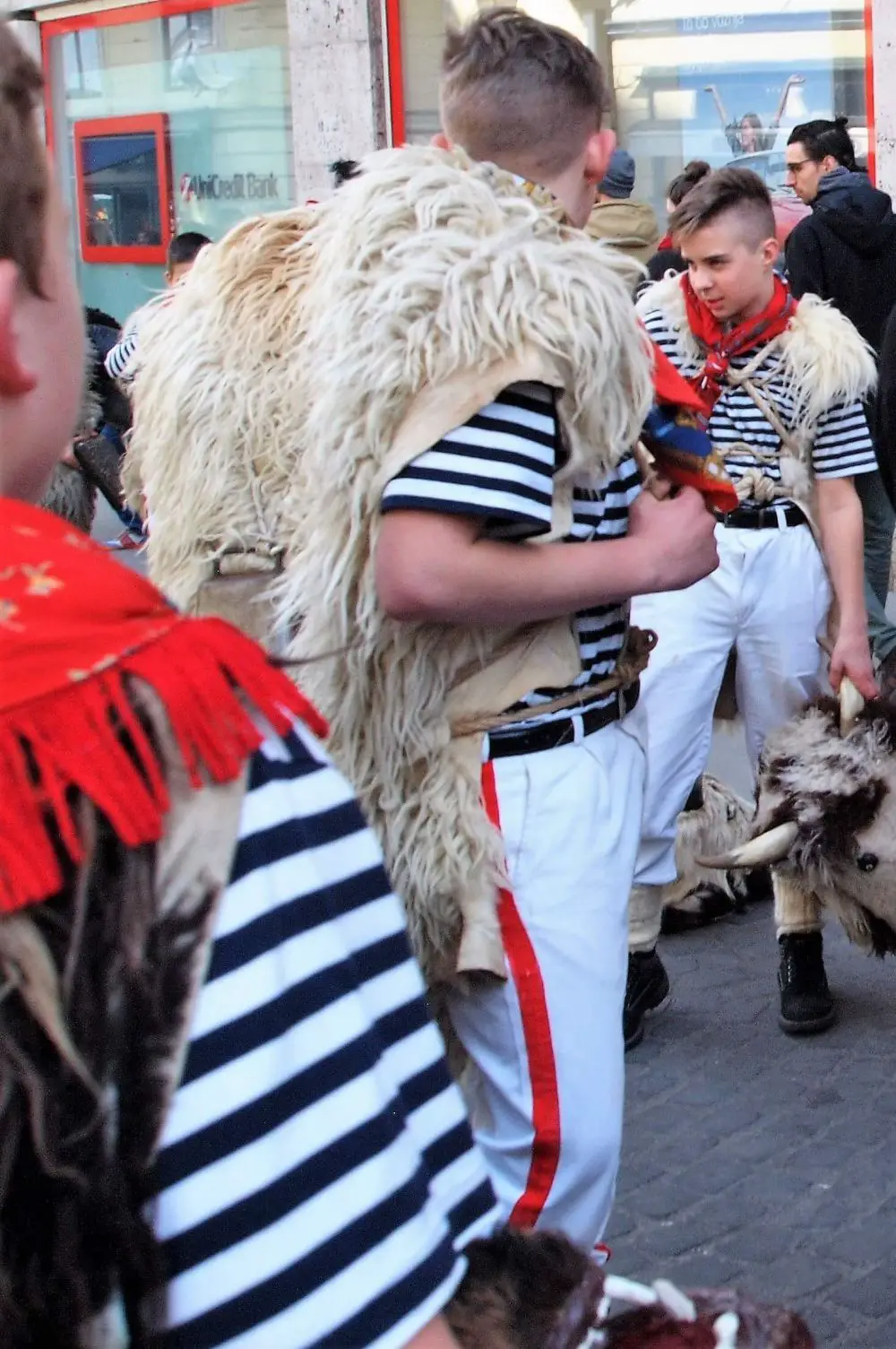
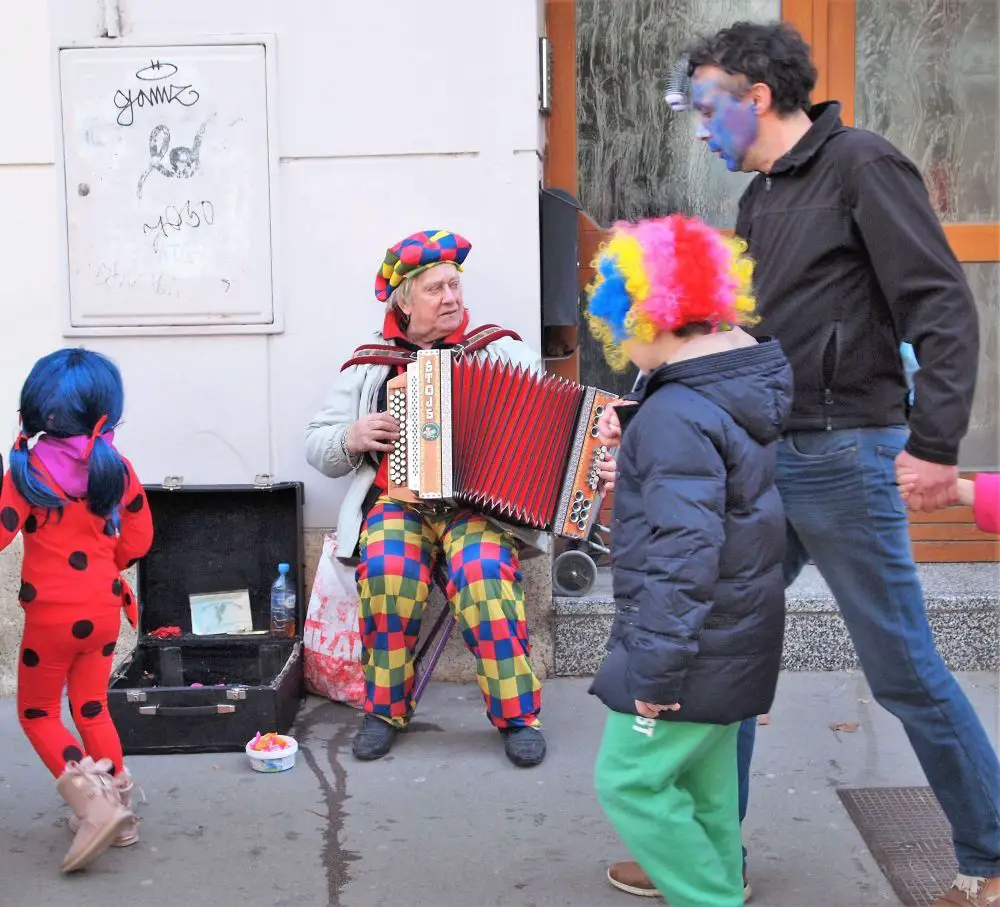
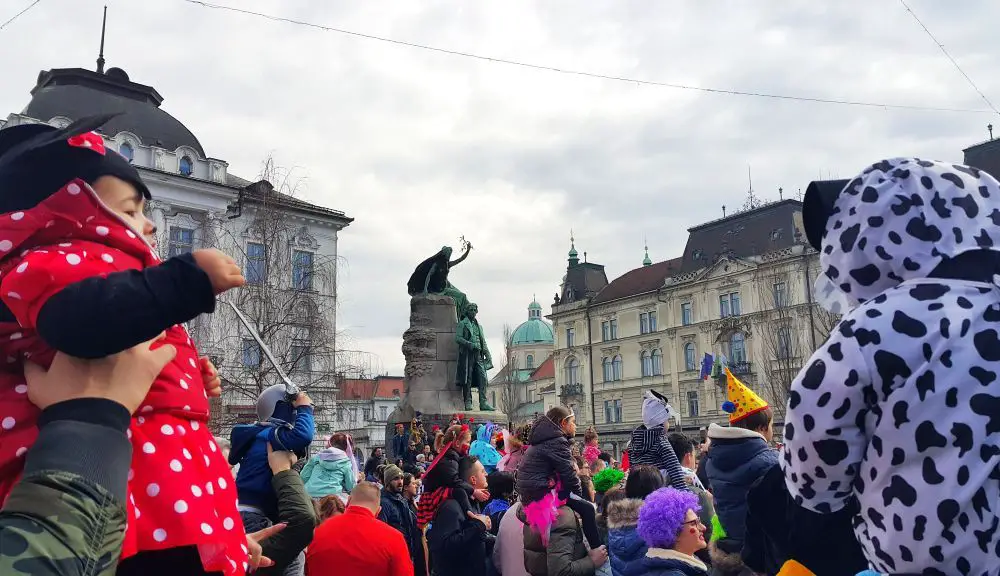
Reports of large crowds celebrating one way or another also come from other parts of the country.
Moreover, in a celebrity twist, various stories in the media claim that on Friday night a large party crowd in Ptuj irritated a drunk Olympian Filip Flisar to the point that he attacked and broke the shield of a police van, which landed him in jail for several hours.
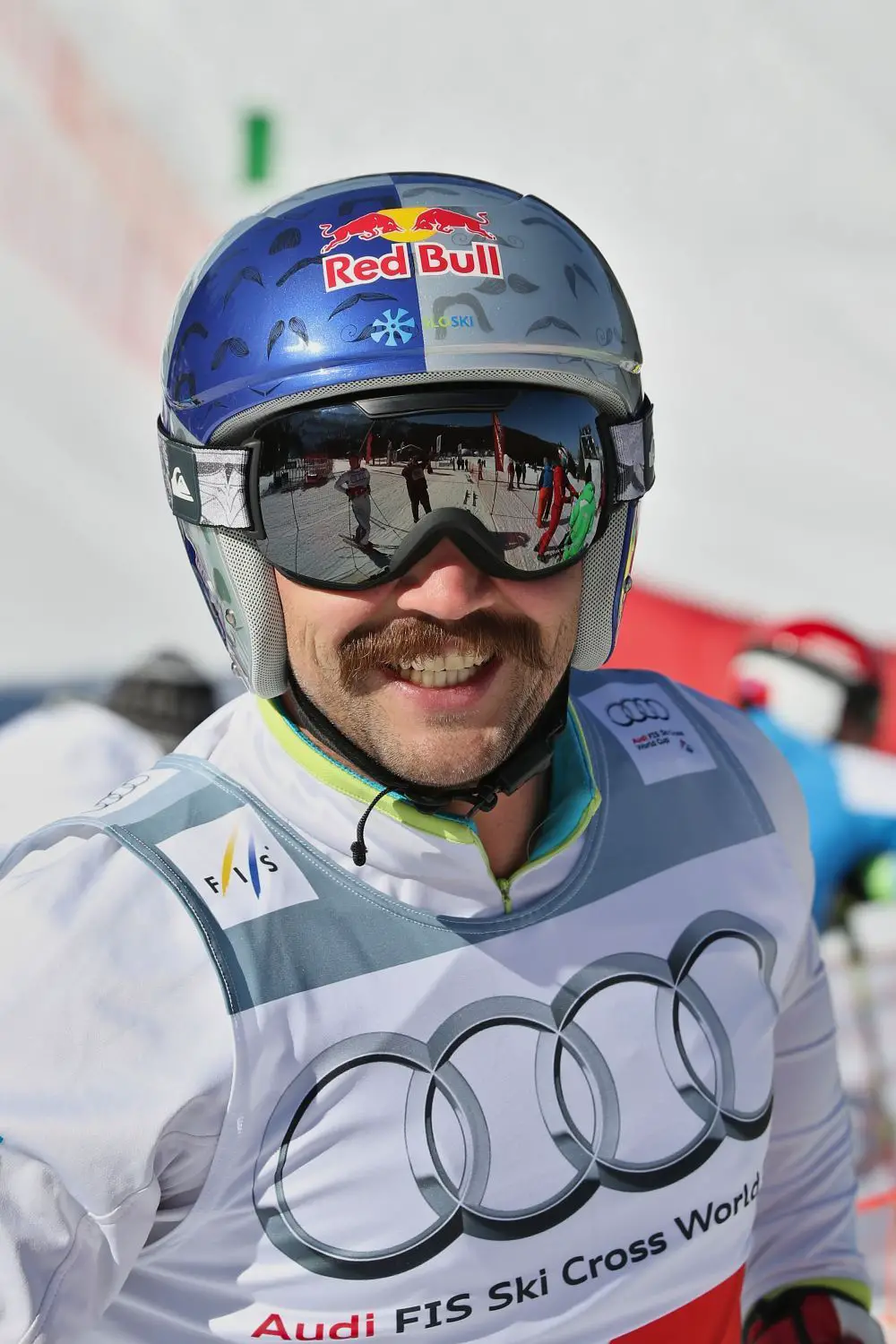
As reported by the STA, after his release the athlete is quoted as saying: "I'm not running away from my actions," adding that a difficult season had left him with some frustration to release.
He went on to explain: "There was a thousand people [at the carnival] who were all very drunk and everybody tries telling you something, everybody's getting at you…[But] II have to face up to the consequences of my actions, after all, they are my doing. Let this be a cautionary tale for me and everybody else. Let's love each other and everybody will be happier."
While the general question being raised is whether or not such a behaviour becomes a national hero, we’d like to know what Filip Flisar was doing out on Friday night in Ptuj without wearing a costume.
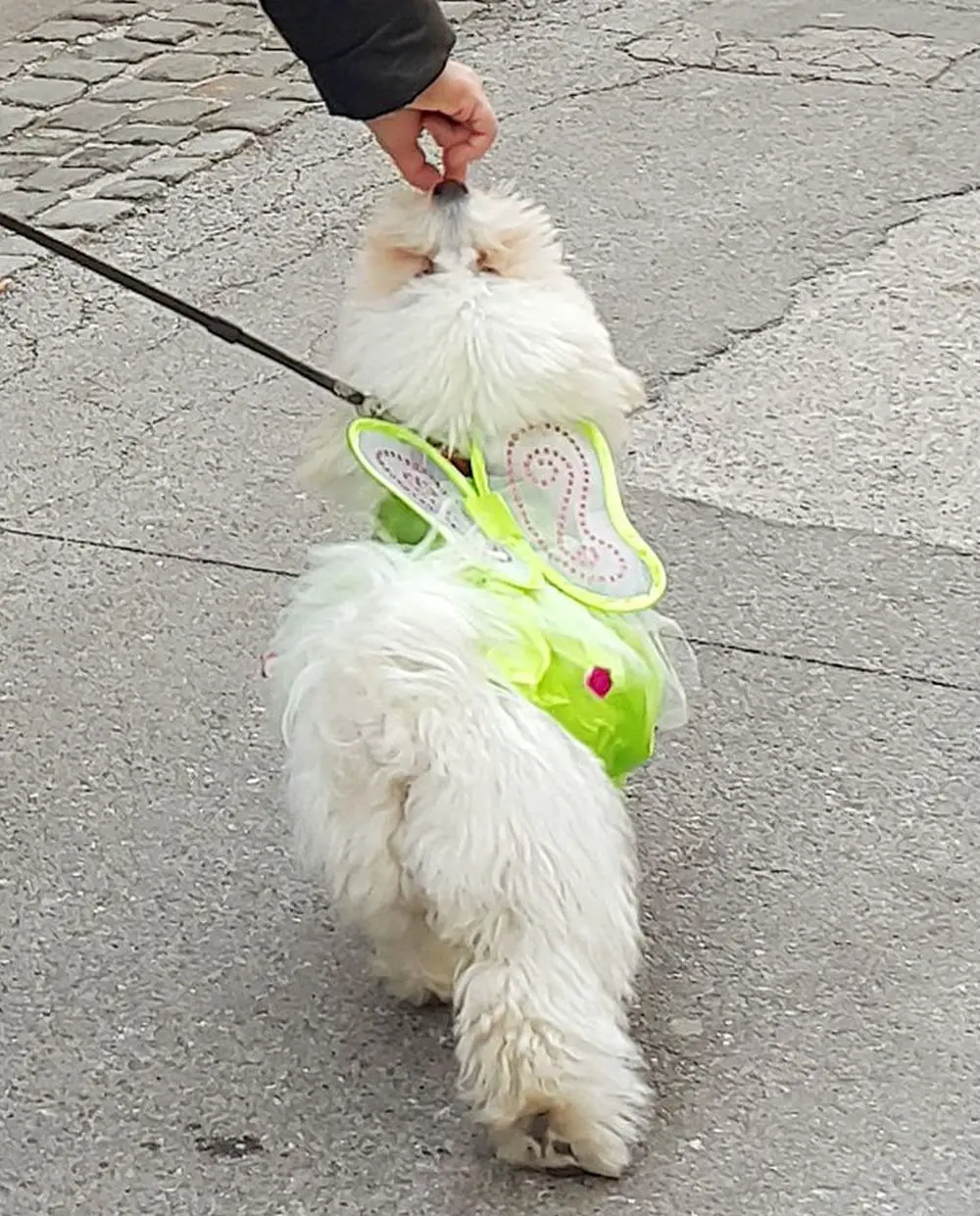
STA, 2 March 2019 - Around EUR 7.8m in budget funds was spent on migration-related issues last year. The Government Office for the Support and Integration of Migrants accounted for the bulk of spending, EUR 3.48m, and it estimates outlays will rise to EUR 4m this year.
Of that, EUR 3.6m will be spent on supplies and services, EUR 100,000 for transfers to individuals and households, and EUR 300,000 for other domestic transfers, Finance Ministry data show.
The Foreign Ministry spent roughly EUR 1.2m on helping refugees in Turkey and Western Balkans, a figure projected to drop in 2019, with the Slovenian Armed Forces booking EUR 2.4m in migrations-related expenses.
The Interior Ministry, the Public Administration Ministry, the Administration for Civil Protection and Disaster Relief, the government's secretariat-general, and the Financial Administration did not have any migration-related expenses last year.
The Health Ministry did not spend any money on migrants either, although hospitals and health centres recorded around EUR 338,000 in migration-related expenses.
All our stories on migrants and Slovenia can be found here
Ljubljana had its official Pust (Carnival) parade on Saturday March 2, but the real day is this Tuesday, so don't be alarmed if you see people dressed up in strange ways downtown or at night, and if you've ever felt the urge to wear a cheap wig, fake nose or Venetian mask in public that would be the time to indulge. Another special day this week is Friday, March 8, Women's Day, although in keeping with the theme "a woman's work is never done" this isn't a public holiday.
Two kurenti at Pust. Photo: JL Flanner
Young kurenti. Photo: JL Flanner
Photo: JL Flanner
If you're not in town for the week of this guide (March 4 - 10, 2019) then you can see all the editions here, and you can enhance your stay in the city and impress or annoy friends and companions by learning some obscure facts about the city here, and the Castle here.
As ever, clicking on the venue names in the list below should get you more details with regard to the time, price and location, as well as other events on at this place in whatever week you're here. Finally, if there's something you want to promote in a future edition of What's on in Ljubljana please get in touch with me at flanner(at)total-slovenia-news.com
- Cinemas and films
- Clubbing
- Live music
- Opera, theatre and dance
- Harm reduction and drug testing
- Things to do with children
- LGBT+ Ljubljana
- Ljubljana Castle
- Museums and galleries
- Other things to do in Ljubljana
- Daytrips
- Getting around
Cinemas and films
You can read about all the cinemas in town here, while a selection of what’s playing this week is below, and note that kid’s movies tend to be shown in dubbed versions, so do check before driving out to a multiplex and dropping off the young ones if they can't understand Slovene. Parents should also pay attention to Kinobalon, which is Kinodvor's regular weekend series of film screenings and events for children, from babies on up, with special parent/child events, "first time in a cinema" screenings, and babysitting. Learn more about it here, and see the current schedule here.
Cankerjev dom – You don’t want to watch Free Solo on your phone, and while this Oscar-winning documentary is almost certain to turn up elsewhere in the months ahead, you can catch it here on Tuesday , March 5, at 19:00.
Kinodvor – The arts cinema not far from the train station is showing, among other features, Green Book, If Beale Street Could Talk, Beautiful Boy, Faces Places, The Undamaged, Transit, and Colette.
Kinoteka – This revival cinema isn’t far from Kinodvor, at the train station end of Miklošičeva, is showing has a week of ethnographic films from Norway, Italy, the US, China, Canada, Switzerland, Slovenia and elsewhere. See the programme here (and check the dates, as the link will take you to whatever's showing the week you read this).
Kino Bežigrad - This slightly out of town theatre is showing, among other features, Replicas and Alita: Battle Angel, while starting Wednesday is Captain Marvel.
Kolosej - The multiplex out at BTC City Mall is playing all the big movies, which this week include a dubbed version of How to Train Your Dragon: The Hidden World, Green Book, Vice, Ralph Breaks the Internet: Wreck-It Ralph 2 (dubbed), A Star is Born, Bohemian Rhapsody, Escape Room, Lego Film 2, Cold Pursuit, Alita: Battle Angel (2D and 3D), Qu'est-ce qu'on a encore fait au bon Dieu?, Happy Death Day 2U, Dumplin', Instant Family, Mia et le lion blanc, a dubbed version of Liliane Susewind, and The Favourite. New this week are Replicas, Izbrisana, a dubbed version of The Queen’s Corgi, and starting Wednesday is Captain Marvel.
Komuna – The cinema in a basement behind Nama department store is showing Bohemian Rhapsody, The Favourite, and Green Book.
Clubbing
Compared to some European capitals it can seem that nightlife in Ljubljana ends rather early, especially along the river, but there are still bars that stay open late and clubs were you can dance until dawn, and perhaps the best place to stumble across something interesting is the legendary Metelkova. Be aware it's a grungy kind of place and not for all tastes, but also that there's considerable variety to found within the various clubs there, from death metal to electropop, gay cabaret to art noise. You can read "the rules" of the place here. And if you're curious about how the place started then read our story, and look at some pictures, about last year's 25th anniversary.
Božidar - Saturday, 22:00 to 03:00, Bgirls Do It Better. “Sports and cultural association GOR has prepared you a special evening of rap, soul and funk. Behind the turntables we welcome DJ Bijan, Dj Lazy One, DJ Moska. We also present you a very special show by an emerging local female rapper Sahareya.” The event is free to enter.
Channel Zero – There were Pust events last week, but the real day is Tuesday, and there’s an all-nighter here for you to get dressed up for, with the music being played by Dirty Skunks, Rope, Jerry, Sunneh, Fogy, and Stojc. One the great things about doing this guide, and perhaps about reading it, is learning how to decode the names of events, and Friday, March 8, presents the challenge and delight that is SUBØ: Tigerbalm w. KG. As regular visitors to what’s on… or klubland might know, this will be an house and electronic event, with the music lined up by DJs (Goon Club Allstars, UK), CL_TR, ESTERA, Terranigma, and b2b DVS, and the visuals provided by VJ 5237.
Gala Hala – Tuesday night there’s Maškarada 2.0, another Pust event, so dress for fun and enjoy the sounds of house and techno provided by Blažen DJ & Jaša Bužinel. Friday you can then come back to Metelkova to dance till 5am with Zeleno sonce 121: Dan želja, which is funk / soul all-nighter with DJs Bayo and Udo Brenner. The next night, and again until 5am, it’s Rostfraj Onehundrid, which is a centenary event for the Rostfraj crew, who’ll be playing “odfukane klubske muzike”, with DJs Žongler Mastif, Sanja, and Sofija Leron aka KaktusKaktus.
Klub Cirkus – Tuesday there’s a Pust party for students (and others), and so you can wear a costume if you want, with the music being “hip house” and house music. Friday DJ Lea is in the house, along with the New Age Gang, playing “dance”. Saturday, the day after Women’s Day, it’s HouseKeeping pres. Mike Vale, Buchan & Suano. It’s a house music event.
Klub K4 – The klub 4 kool kids that’s now more than 30 yrs old has a Pust party of its own on Tuesday, with DJs Cookie, Gabi1808 b2b Re3600 and Mili Kumara. Friday there’s an event called Phi w/ Aleksi Perälä (Rephlex, Trip / FIN). Saturday it’s then Solvd, with DJs Christian Kroupa / Alleged Witches, Alex Ranerro, and Mobo (Magnetik Music).
Live music
Božidar – Thursday, 20:00 to 01:00 there’s Jazz klub Mezzoforte, offering Freestyle Karaoke & Jam Session, with Cene Resnik on saxophone, Gašper Peršl on drums, and Thierno Diallo on bass.
Cankerjev dom – Juan De Marcos González Afro-Cuban All Stars (Cuba) will be playing here on Saturday.
Cvetličarna – Friday you can enjoy the Mad Caddies playing live ska at this venue, while on Saturday it’s the turn of the silver fox of Slovene pop, Jan Plestenjak.
Channel Zero – Thursday there’s a live show from Phoenician Drive, which the publicity claims “invented Afrikrautrock”, which sounds fantastic (krautrock being the best rock). Check them out below, followed by - I'll take any excuse to share this - a classic krautrock freakout by Damo and the boys from Can.
Kino Šiška – Wednesday Leon Matek will be performing to promote his new album, with support from “guests”.
Klub Gromka – Hardcore punk, live on stage, Thursday, with Svetlanas, Hak Attak, and Material Girls.
Ljubljana Castle – Friday, Women’s Day, March 8, you can go up the hill and see Like The Rolling Stones, a tribute act, at 21:00.
Orto Bar – Thursday night it’s black/death metal with Dalkhu and Agan. Friday there’s Dan Rock Žena 2019, which is a rock night for Women’s Day with Hellcats, Tri kapljice, and Checkmate.
Slovenska filharmonija – Wednesday the pianist Peter Milić is in town, playing Beethoven, Chopin (the piece shown below), Brahms, and Dutilleux. Thursday and Friday the Orchestra will be playing some Mahler under the very capable baton of James Tuggle.
Opera, theatre and dance
Cankerjev dom - Sergej Polunin will be dancing here Monday and Tuesday, 19:30, in a show called Paradoks – Sacré, with the music ot Stravinsky and the choreography of Yuka Oishi. You can see him below in a different show.
Gledališče IGLU - IGLU TheatreSaturday night this group is usually putting on an Englishimprov show somewhere in town, but it’s generally promoted after this is written, so check the Facebook before putting on your shoes.
Mini Teater Ljubljana – The English schedule of varied performances for the month is here.
Pocket Teater Studio – Thursday it’s Afro Brazilian Jazz - Where Rio de Janeiro meets Bahia. It’s a small place (very), so reserve your seats and do it now at This email address is being protected from spambots. You need JavaScript enabled to view it.. You can see some of what you’ll be missing if you delay below.
Harm reduction and drug testing
Drogart is an organization that aims to minimise harm on the party scene, and offers drug-testing services and reports on their webpage. It’s in Slovene, but you can Google translate it or work things out yourself, and our story on the group is here. You can find the latest warnings on fake drugs and high strength pills and powders (in Slovene) here. However, be aware that all the usual drugs are illegal in Slovenia.
CBD is legal, though, and our retailer of choice can be found on Trubarjeva cesta - read more about Sena Flora here.

Things to do with children
You can find our Top 12 list of things to do with kids in Ljubljana here. If want to read more about the philosophy behind the wonderful House of Experiments look here, while our trip to the Museum of Illusions is documented here, and there’s always riverside walks, pizza and ice cream. With regard to the latter, take a look at our guide to six places that serve good ice cream in winter.
Balassi Institute – Thursday 17:00 – 17:40, there’s a Music Workshop for Young Children (0 to 4 years) with Julcsi Laposa, all free of charge.
Mini Teater Ljubljana – The season sees a lot of puppet performances for children, in Slovene, at this theatre not far from Križanke. The English schedule for the month is here.
Ljubljana Puppet Theatre - The puppet theatre near the Central Market and next to the Castle funicular has a full programme or shows, for children and adults, with the schedule here.
LGBT+ Ljubljana
If you want to learn more about Ljubljana Pride, then take a look at our interview with its president here. If you're looking for more general links on "gay Slovenia", including a history of the scene and various projects, then you can find that here, while our stories about the community can be found here.
Klub Monokel - This lesbian bar in Metelkova is open every Friday evening, but no other events are planned this week.
Klub Tiffany – And the gay bar next door is also open on Fridays, while every Monday until June 2019 there's tango at 18:00. This week, on Tuesday, 16:00 to 19:00 there’s a DJ class, with details here. Then Thursday, starting 19:00, it’s a café evening with live music from Croon.
Pritličje – This seems to be the only "always open" LGBT-friendly cafe / bar / events space in town, and perhaps the country, so it's a good thing it's such a good one, open from morning to night, and with fliers and posters letting you know what's happening outside the narrow confines of, say, a general interest online what's on... guide. This week, Wednesday 19:00, there’ll be a discussion on Sexism and the LGBT+ community (in Slovene, and thus Seksizmi v LGBT+ skupnosti).

Screenshot from Google Maps, showing the location of the Castle vineyard
Ljubljana Castle
The city’s main attraction is said to be the top tourist draw in the country overall, and to my mind it earns a spot near the top just for the history and views. But beyond that the current owners, the City of Ljubljana, have laid out a varied, interesting and enjoyable programme of events, one that rewards regular revisits.
I try and get up there every Saturday morning to clear my head and move my feet on the trails, and never tire of that end of the hill. At the other end, where the Castle sits, there’s a lot more than fresh air on offer. There are guided tours, restaurants, a café, Castle museum, puppet museum, a Watchtower you can climb to the highest point in the city, art shows, dances, live music, movies under the stars, festival days and more – enough to reward multiple trips up the hill through the year. All of these activities and events can be found on the Castle website, while on TSN you can see “25 things to know about Ljubljana Castle” here, and “Ten Ways to Enjoy Ljubljana Castle” here.
Museums & Galleries
Most public galleries and museums are closed on Mondays, although not the National Museum, and - as noted at the start
Plečnik's desk. Photo: JL Flanner
Plečnik’s House is worth a visit if you want to learn more about the architect who gave Ljubljana much of its character, and it's also in a really nice part of town, Trnovo, just a short walk or cycle upriver. Read about our guided tour here.
Balassi Institute – The Hungarian culture centre has an exhibition entitled “Encounters in Visual Art” introduces works of selected visual artists, painters and sculptors, who define today's art scene in Hungary and Slovenia, as promoted with the image below. Free to enter, this venue is next to a Spar and Hofer, and not far from Dragon Bridge, and always has something interesting going on. Learn more here.

Cankerjev dom – On until February 28 is the exhibition Ivan Cankar and Europe, Between Shakespeare and Kafka, while until March 10 there’s a photographic show on the Ljubljanica, with images of the city’s river captured by Bojan Velikonja. Showing until the end of March is a selection of specimens from The Newspaper Museum.
City Museum – The Museum in French Revolution Square an interesting permanent exhibition on the history of Ljubljana, from prehistoric times to the present day, with many artefacts, models and so on that bring the story alive.You can read about my visit here.
The Faces of Ljubljana in the City Museum. Photo: JL Flanner
City Gallery - Not far from the Robba Fountain and running until March 24 is a show presenting drawings by Iztok Sitar, the original pages that were used to make his graphic novels over the last three decades. Rather adult in nature – think Robert Crumb in terms of sex, drugs and religion, in places – it’s free to enter and has much to enjoy. One of the pictures I took on my visit is below.

Photo: JL Flanner
MAO – The Museum of Architecture and Design has much of what you'd expect, and until March 25, 2019, has a show on Ljubljana and it's relation with water.
Moderna galerija – The main branch of this gallery, to be found near the entrance to Tivoli Park, has a good collection of modern art, as well a nice café in the basement. Running until March 31 is a major show on young Slovenian painters, Time Without Innocence – Recent Painting in Slovenia, where you’ll see works like the following. You can read about my visit here (I loved it).

Iva Tratnik, Mating Season Totalitarianism, 2014, oil on canvas, 210 x 194 cm

Arjan Pregl, from the Carnival series, oil on canvas (6 paintings 120 x 100 cm; 3 paintings 80 x 60 cm), 2018. Mr Pregl was recently voted "worse than Hitler" on Twitter.
National Gallery – The country’s main gallery has “the best” of what’s on offer from the Middle Ages to non-contemporary modern visual arts, and is in a great location for exploring other areas, just by Tivoli Park and opposite the main branch of the Moderna galerija. You can read about our visit to the room containing sacred art from the Middle Ages here.

JL Flanner
The real Robba Fountain can be found in the entrance to the National Gallery - the one you see in the Old Town is a genuine fake, as seen below and reported here.

Photo: JL Flanner
National Museum of Slovenia – There’s plenty to see in the permanent collection here, from Roman times, Egypt and more. Meanwhile, the museum's Metelkova branch, located between one branch of the Moderna galerija and the Ethnographic Museum has some rooms on Church art, furniture and weapons, with the latter including more guns than you'll see anywhere else in town, and quite a thrill if coming from a nation where such objects are not household items.
Natural History Museum – On until the end of June 2019 is Our Little Big Sea, which takes a look at the oceans.
Slovene Ethnographic Museum – The museum currently has a temporary show on Bees and Beekeeping, on until June 16 2019, as well two permanent exhibitions. One of these is called Between Nature and Culture, and has a great collection of objects from Slovenia and around the world, well worth the trip up to the third floor to see it (as recounted here). This place is located near the newer branch of the Moderna galerija and Metelkova.
Union is "the Ljubljana beer", but now both it and Laško are owned by Heineken. There are many local brews on offer around town, though, if you want to explore IPAs, stouts, wheatbeers, sours and so on Photo: JL Flanner
Union Experience – The Ljubljana-based brewer has a museum showing the history of the company, with the ticket also including access to part of the factory and a few samples of the product. You can read about our visit here.
It's not a formal museum, but if you're interested in "Yugo-stalgia" then you'll enjoy a trip to Verba, a small, privately run space that's crammed with objects and pop culture items from the era, and is conveniently located at the start of one of the short walks to the castle. It's also a great place to take pictures, if you leave a donation, and you can read more about it here.

Verba. Photo: JL Flanner
Alternative Ljubljana isn't a museum or gallery, as such, but instead turns the city streets into a museum and gallery. Learn more about their tours of street art, history and LGBT Ljubljana here.

Photo: JL Flanner
Other things to do in Ljubljana
If you'd like to spend an evening painting with others, then take a look at Design with Wine, which organises painting parties on Trubarjeva cesta,

If you want to see some antiques, then check out the wonderful Antika Carniola, as discussed here. The man behind it, Jaka Prijatelj, has a fine eye for life on this street, as you can see on his Facebook account.
Photo: JL Flanner
If you’re in town and want to go jogging or walking in nature, why not take another look at the Castle, with a brief guide to the trails here. If you want something bigger, head to Tivoli Park.
And if you're bored with the Old Town, why not take a walk, cycle or boat ride to nearby Špica and enjoy the riverside life. Learn more about that here.

visitljubjana.si
![]()
maxpixel.net, public domain
Want to stretch and breath? Then check out our list of drop-in yoga classes for tourists, visitors and the uncommitted. If you're heading to the coast, check out our interview with a yoga teacher who offers breakfast sessions there, while if you're staying in town (or nearby) and want to try some "family yoga" then you can learn more about that here and maybe get your kids to calm down a moment or two.
There are some golf courses near Ljubljana, but even ones further away are not far, as seen in our list of all the golf courses in Slovenia. Note that these close when the snow starts, if it ever does this year, in which case you might be interested in what's new at Slovenia's ski resorts for 2019, as reported here.
![]()
Photo: maxpixel.net, public domain
Daytrips
Most of Slovenia is only a few hours from Ljubljana, and you can easily visit Lake Bled, Lipica Stud Farm, Postojna Cave, Predjama Castle, the coast and other locations, while if you'd like to take a photo of from that bench in Bled, then you can learn how to get there here. If you’re looking for something more ambitious, then check out our recent guide to the 17 members of the Association of Historical Towns of Slovenia

Photo: Google Image Search
Getting around
If you want to get a Ljubljana Tourist Card, which gives you travel on the city buses and entry to a lot of attractions, then you can read more about that here, and if you want to use the bike share system, as useful for visitors as it is for residents, then you can learn more by clicking this. Visitors with reduced mobility will be pleased to find that downtown Ljubljana is generally rated as good with regard to accessibility, and that there’s a free, city-sponsored app called Ljubljana by Wheelchair highlighting cafés, attractions and so on with ramps, disabled bathrooms and Eurokey facilities, which you can read about and download here. Manual wheelchair users can also borrow, for free, an attachment that will motorise their equipment, as reported here.

Screenshot from a Twitter video
If you’re driving into town and don’t know where to part, our guide to how to park in Ljubljana is here.
There aren't many places to eat after midnight, and most of them are by the train station, as reported here.
Want / need cigarettes but the stores have closed? Here's an incomplete list of bars downtown that will satisfy your craving for the demon weed. While if you’re having trouble with the ATMs then here’s a guide to the Slovene you’ll see on screen. If you get a hangover then find out where to get paracetamol (and prescription drugs) in Ljubljana here, while details on emergency birth control can be found here.
Ljubljana is a small and relatively safe city, but if need to contact the police then there’s a special number for foreigners, and that’s 113.



